

Mapping the Retail Customer Journey: How to Get Started
Maximizing the Retail Supply Chain
How to revolutionize your brand approach to create a truly frictionless retail customer experience
The modern retail customer journey is sprawling, often spanning multiple channels and dozens of touchpoints or more. Each of these touchpoints represents an interaction between a consumer and a brand that has the potential to either convert a shopper into a buyer — or to drive them into the arms of a competitor. To avoid this second outcome, brands must make every effort to optimize each touchpoint, which first requires developing a holistic view of their companies’ customer journeys through journey mapping.
What Is Customer Journey Mapping?
A customer journey map is exactly what it sounds like: A visual representation of the various touchpoints an individual interacts with along their journey from prospect to the customer (and, in many cases, to advocate). Customer journey maps serve a valuable purpose, helping retailers better understand how their customers think, what their needs are, how and where they shop, and more — all with the goal of delivering more targeted brand messaging and consistent omnichannel service to nurture customers down the path.
Customer journey mapping — sometimes known as user journey mapping — requires brands to identify with their target audience and try to see things from their perspective. In doing so, retailers can develop a firsthand appreciation of the kinds of pain points their customers typically experience and proactively address those issues.
Mapping the retail customer journey also enables brands to identify and eliminate any gaps within their existing services and communications to ensure that customers are fully supported at every stage of the journey.
Why Customer Journey Mapping Matters
Although the retail customer journey might seem simple when taken at face value — a customer needs a product, finds one to their liking, and makes a purchase — it’s actually surprisingly complex.
No two customers are alike; each one comes with their own unique set of wants, needs, challenges, and expectations. To convince a prospective buyer to make a purchase — let alone become a loyal customer — a retailer must accommodate all of these elements and provide a highly personalized, end-to-end experience.
This is a tall order for any brand but mapping the customer journey can make things more manageable by providing retailers with a comprehensive view of all possible touchpoints and helping them understand the cause and effect of customer interactions.
But that’s not all — other benefits to mapping the retail customer journey include:
- Deeper Insight: By placing themselves in the customer’s shoes, retailers gain valuable insight into how their customers think, feel, and act to better empathize with their overall experience. Brands can then channel this newfound perspective into designing customer journeys that meet actual consumer needs.
- Proactive Issue Resolution: Another benefit to seeing things from the customer perspective is that brands can recognize problems and pain points within the buyer journey that they may have otherwise overlooked. With a fresh set of eyes, retailers can tackle these issues head on — and even proactively address future roadblocks — thereby minimizing customer frustration and allowing for a seamless experience.
- Comprehensive Coverage: From in-store to online, the customer journey spans a wide variety of channels and individual touchpoints, with new ones emerging every day. Without a clear sense of all the potential ways customers might interact with their brand, retailers risk letting prospective buyers fall through the cracks. Customer journey mapping provides a comprehensive view of the entire user journey across all touchpoints, enabling retailers to see all eventualities and ensure they have total coverage, no matter where their customers shop.
- Personalized Experiences: Mapping the retail customer journey can offer insight into how and where a brand’s customers prefer to shop. Armed with this information, retailers can interact with customers through their preferred channels and leverage data analysis — made possible through the use of a customer data platform — to deliver personalized communications and targeted offers.
- Optimized Brand Messaging: With greater visibility into how customers interact with their brand, a retailer can develop a more accurate understanding of what messaging and which campaigns are most impactful, and at what stage in the journey to deploy them. And by plotting the entire retail customer journey from start to finish, brands can recognize potential gaps in coverage and fill them in as needed.
- Cross-functional Stakeholder Alignment: From a business perspective, customer journey mapping is a powerful tool for driving stakeholder alignment because it clarifies business needs and priorities, provides valuable context for business decisions, and helps teams across the organization understand their role in supporting the customer journey.
- Connected Journeys: The ideal retail customer journey should be, above all else, totally seamless and consistent. Shoppers should receive the same level of personalization and high-quality service regardless of where they are in their journey or which touchpoint they’re interacting with. In order to deliver this kind of cohesive experience, retailers need to be able to see all of the possible paths a buyer can take and the ways in which these paths flow together and diverge.
Key Stages of the Retail Customer Journey
Although no two customer journeys are identical, they tend to follow the same basic structure:
- Awareness: During this initial stage, the customer becomes aware of a need they have or an issue they face, for which they’re eager to find a solution. Since the Awareness stage is often the first step of the customer journey, it tends to be heavily research-based — customers might talk to friends or family members to see if they have any recommendations or go online to get a sense of what options are available to them. From a brand perspective, the Awareness stage is their opportunity to engage with the customer and make them aware of the company’s products.
- Consideration: A customer in the Consideration stage has completed their initial research, identified a few viable options, and is now evaluating those options against each other to see which best meets their needs. At this point, a brand has the customer’s full attention but needs to help them see the value their product can deliver. High-touch service is critical at this stage and could spell the difference between a customer choosing one company’s product over another.
- Purchase: Having weighed their options, the customer is ready to make a purchase. Although the customer has made their decision, the retailer isn’t entirely off the hook — it’s important that the purchasing process be as easy and convenient as possible to avoid scaring the customer off at the last minute.
- Retention: The customer has made an initial purchase with a brand — now it’s time to ensure that they keep coming back for more. Although loyalty rewards programs are a valuable touchpoint for the Retention stage, they’re only the beginning . Retailers should also solicit (and actually listen to) feedback and routinely reengage customers through personalized, high-value offers and messaging to maintain strong connections and build a long-lasting customer relationships .
- Advocacy: The final, and perhaps most important, stage of the retail customer journey is the Advocacy stage. By this point, a retailer has earned itself not just a loyal customer, but one who’s willing to sing the praises of its brand to anyone who will listen. Key touchpoints in the Advocacy stage include online customer communities where loyal shoppers can interact with other brand advocates, referral programs, and special in-person events where customers can engage directly with the brand.
It’s important to note that each of these stages includes many individual touchpoints that span multiple channels. Customer journey mapping offers the perfect opportunity to capture an end-to-end view of all of these touchpoints and optimize them in order to make the buyer’s journey as seamless as possible.
Visualizing the Retail Customer Journey
Your customers are looking for shopping experiences that are seamless, personal, and joyful — data is the way to deliver them.
How to Create a Retail Customer Journey Map
At a high level, the process of creating a customer journey map should look something like this:
- Establish the “why.” Although journey mapping is an essential process for any brand, it’s important to establish a clear reason for creating a journey map as well as to define goals and objectives at the outset. This not only imbues the journey mapping process with purpose, it also sets parameters and creates success metrics for continuous improvement.
- List out all touchpoints. Each touchpoint represents a single interaction between a customer and a brand, during which a customer has the chance to form an opinion of that brand. Touchpoints can take many forms, from an in-person conversation with a sales associate, to reading a third-party review site, to a conversation with a chatbot . Listing out all touchpoints can be a significant undertaking — a single company can have hundreds of touchpoints, if not more. It’s an essential step of the journey mapping process because it provides valuable insight into which touchpoints customers engage with and how often, which can offer insight into how they think and feel.
- Create buyer personas. A buyer persona is a fictionalized customer intended to represent a specific segment of a company’s target audience and to help contextualize how consumers within that segment might approach purchasing decisions. In order to ensure accuracy, buyer personas should be based on actual customer data, as well as feedback shared by existing customers. Each persona has its own unique set of needs, goals, and pain points and therefore its own distinct journey. Brands will want to narrow their focus and determine which personas are high priority when they first begin journey mapping.
- Create a customer journey map. Or, as the case may be, multiple maps serve different buyer personas.
- Visualize the journey. Once a retailer has mapped the journey, they need to undergo it themselves. This step is vital, as it provides brands with a firsthand perspective on which touchpoints require additional support. Data analytics can serve as a valuable second set of eyes, so to speak, at this stage because it can provide additional context about areas in need of improvement and insight into what changes need to be made.
- Revisit the journey regularly. Customer journeys are constantly evolving, so it’s in brands’ best interest to go through this exercise on a routine basis. This is where many companies fall short: Although 75% of customer experience leaders report to using customer journey maps, only 56% treat theirs as a living document and keep them up-to-date. Failing to update customer journey maps according to changes in the marketplace and the emergence of new trends and channels increases the risk of buyers falling through the cracks and retailers losing out on business. Failing to update customer journey maps also means brands risk missing out on the opportunity to capitalize on new technologies, such as conversational artificial intelligence and intelligence derived from machine learning.
Beyond this general process, here are a few things retailers can do to ensure that their customer journey mapping experience is successful:
- Talk to customers. Putting yourself in the customer’s shoes is a great start, but it’ll never be as valuable as going straight to the source. From surveys to user groups to reviews, there is a number of ways to solicit feedback from buyers and get their firsthand perspective on what the journey should look like.
- Know that the journey isn’t linear. Although it would be ideal if all customers moved straight through the Awareness to Advocacy pipeline, many shoppers go through the first few stages only to backtrack. Understanding this is key because it enables brands to either build out new touchpoints or optimize existing touchpoints to get those prospective buyers back on track.
- Understand the difference between journey mapping and experience mapping. Though closely related, customer journey and experience maps differ widely in scope. Customer journey maps typically focus on a single product or service and are a powerful tool for customer retention. Customer experience maps are much broader and span all of a company’s offerings and is often used to refine a brand’s marketing strategy.
- Consider actions, emotions, and motivations. Many retailers only take customers’ actions into account when journey mapping. Going a step beyond to understand how customers feel at each stage of the journey and their underlying motivations paints a much more detailed picture and enables brands to mitigate any negative emotions consumers might experience as they shop.
- Keep pain points in mind. One of the primary motivations behind customer journey mapping is to eliminate any obstacles that might prevent shoppers from making a purchase. With that in mind, it’s important that retailers both talk to consumers directly about what challenges they typically experience and leverage data analysis to identify — and solve — those pain points.
- Streamline the journey. That means eliminating any unnecessary interactions that would slow the customer down or potentially cause frustration. Customers’ time is precious, and many do not want to jump through additional hoops to get the information they need, so it’s best to keep things simple.
Much like the journeys they represent, no two retailers’ customer journey maps will be exactly the same. The processes and best practices presented here should give brands a good head start, but it’s important to tailor each according to your company’s needs.
Develop Seamless Customer Journeys Through Data
In order to succeed in today’s cutthroat competitive retail landscape, brands must deliver seamless, customer-centric journeys and experiences — and data is the key to accomplishing that. To learn more, check out Hitachi Solutions’ very own customer journey infographic or contact us to speak directly to a solutions specialist.

The Who & What Behind the Blog
Deb Marotta, Vice President of Industry Strategy at Hitachi Solutions America, is a seasoned leader in the field of industry strategy and technology. Her broad-ranging expertise spans more than three decades, including a significant tenure as Global Dynamics AX Product Manager at Tectura Corporation. Deb's leadership roles at Hitachi Solutions America and prior experiences at Emtec underscore her commitment to driving innovative solutions and best practices across multiple industries. With her knowledge, strategic thinking, and industry insights, Deb offers in-depth, progressive content to this blog, dedicated to the ever-evolving landscape of industry technology solutions.
You might also like
On-Demand Webinar : Retail and CPG App-in-a-Day
Blog Post : AI in Retail: How Data-Driven Technologies are Transforming the Industry
Whitepaper : Retail Customer Engagement
Blog Post : Omnichannel vs. Multichannel Customer Service
- Woopra Logo
- Platform Customers Pricing Resources Company
- Log in Start For Free
- Automations
- Integrations
- Documentation
Unraveling the Retail Customer Journey: A Comprehensive Guide to Effective Mapping

Customer journeys are the lifeblood of retail. Understanding the unique steps customers take from discovery to purchase is crucial.
In this article, we delve into the intricacies of retail customer journey mapping and its significance in today's rapidly evolving marketplace.
Let's embark on this enlightening voyage.
What Is A Retail Customer Journey Map?
A retail customer journey map is a visual story of your customers' interactions with your brand. It's a depiction of the path customers take from initial contact through to a long-term relationship.
It's a vital tool for understanding customer experience. By capturing all touchpoints and phases in the buying process, it enables businesses to identify opportunities and pain points.
The journey begins when a customer first becomes aware of your brand. This could be through advertising, word of mouth, or a search engine result.
The journey then continues as they gather information, make a decision to buy, and finally make a purchase.
After the purchase, the journey doesn't stop. How does the customer feel after buying? What's their experience with your after-sales service ? These questions form the final parts of the journey map.
By mapping the retail customer journey, brands can empathize better with their customers. It highlights where the customer's experience is smooth and where it's not.
This insight drives improvements in the overall shopping experience.
So, a retail customer journey map is more than a diagram. It's a catalyst for creating a better, more customer-centric business.
5 Phases Of The In-Store Customer Journey
Customers navigate various stages when interacting with a retail store.
Understanding these distinct phases is key to improving their shopping experience.
Let's delve into the five crucial stages of the in-store customer journey: Pre-visit, Entrance, Exploration, Purchase, and Post-Purchase.
Pre-visit Phase
The Pre-visit phase marks the beginning of the customer journey. It's when customers become aware of your brand and what it offers.
This could occur through online research, advertisements, or word-of-mouth recommendations.
During this phase, potential customers form their initial impressions of your brand.
They might visit your website or social media pages, read online reviews, or browse through your online catalog.
In essence, they're gathering information to decide whether your store meets their needs. This phase sets the tone for the customer's future interactions with your brand.
Ensuring a positive pre-visit experience is key to attracting potential customers to your physical store.
Also Read: Customer Journey Optimization
Entrance Phase
The Entrance phase begins when customers step into your physical store.
First impressions matter immensely, and this stage sets the tone for the entire shopping experience.
Here, customers form opinions about your store's ambiance, cleanliness, layout, and staff availability.
Factors like lighting, music, and in-store marketing materials can influence their overall perception.
Customers also start to gauge the level of customer service. They notice if staff members are welcoming and ready to assist.
They may also look for clear signage to guide their shopping journey.
The goal during the Entrance phase is to create a positive, inviting atmosphere. It's about making customers feel comfortable and eager to explore what you have to offer.
Exploration Phase
The Exploration phase is the heart of the in-store shopping experience . This is where customers dive into your product offerings and evaluate their options.
During this phase, customers browse through your store, interact with products, and compare different items.
The organization of your merchandise, the quality of the product displays, and the ease of finding desired items all play crucial roles.
In-store staff can greatly influence this stage. Their product knowledge, helpfulness, and ability to cater to customer needs can enhance the shopping experience.
The goal here is to provide a seamless and enjoyable exploration experience.
When customers feel well-served and find what they're looking for easily, they're more likely to make a purchase.
Also Read: Customer Journey Metrics
Purchase Phase
The Purchase phase is the pivotal moment when a customer decides to buy.
This stage revolves around the checkout process and the final steps that lead to a successful transaction.
Here, customers evaluate their chosen products one last time before making the final decision. They consider factors like price, quality, and perceived value.
The ease of the checkout process also plays a significant role.
At this point, friendly and efficient customer service can make a substantial difference.
Quick checkout lines, multiple payment options, and proactive assistance can help seal the deal.
The goal in the Purchase phase is to make the transaction as smooth as possible. Any hiccups at this stage could deter a customer from completing their purchase.
Post-Purchase Phase
The Post-Purchase phase happens after customers have made their purchase and left your store.
It's about fostering a long-term relationship with them, ensuring they're satisfied, and encouraging them to return.
This phase includes elements like customer service support, return or exchange policies, and feedback collection.
Your engagement with the customer during this time can greatly affect their overall perception of your brand.
Remember, a positive post-purchase experience can turn one-time shoppers into loyal customers.
It can also lead to positive word-of-mouth marketing, boosting your brand's reputation.
The goal here is to leave a lasting impression, ensuring that the customer feels valued and appreciated.
It's about turning a single transaction into an ongoing relationship.
How To Build A Retail Customer Journey Map
Creating a retail customer journey map is a strategic process. It involves data collection, identifying touchpoints, and ongoing revisions.
In the following section, we'll guide you through a step-by-step process to create your own customer journey map, helping you to better understand and enhance your customer's experience.
Also Read: Customer Analytics
Creating a retail customer journey map begins with setting a clear goal.
Your goal could be improving customer service, reducing churn rate, increasing customer loyalty, or optimizing in-store experiences.
Decide what part of the customer journey you want to focus on. Are you interested in the entire journey, or do you want to concentrate on specific touchpoints or stages?
You could also tailor the map to a particular customer persona or demographic group.
This initial goal-setting step provides direction for your journey mapping project. It guides the kind of data you'll collect and the insights you're hoping to gain.
A clear goal ensures your map is focused and relevant. It steers the development of strategies to improve your customer's experience in line with your business objectives.
Remember, a well-defined goal is the foundation of a successful customer journey map.
Keep Tracking & Analytics Tools Ready
With your goal set, the next step is to prepare your tracking and analytics tools.
These are vital for gathering data about your customers and their interactions with your brand.
Your tracking tools could include a website analytics tool like Google Analytics, which provides insights into how customers interact with your online platforms.
Heat mapping tools can also be beneficial for understanding on-page customer behavior.
In-store, consider using tools like customer feedback surveys, mystery shopping, and point-of-sale data analysis.
Technologies like Wi-Fi analytics or people counting cameras can also provide data about in-store customer behavior.
These tools help you gather quantitative data, such as how many people visited your store or website, what they purchased, and how much time they spent.
Having your tracking and analytics tools ready ensures you have reliable data to build your customer journey map.
Collect Data
Once your tools are set up, it's time to collect data. Your goal here is to gather as much information as possible about your customers and their shopping behavior.
Start by gathering demographic data. Who are your customers? What are their ages, genders, locations, and income levels?
This information can help you understand who you're serving and what they might expect from your brand.
Next, collect behavioral data. What are customers buying? When are they visiting your store or website? How much time are they spending? This can reveal patterns in shopping behavior.
Don't forget about attitudinal data. How do customers feel about your brand?
You can gather this information through surveys, feedback forms, or social media sentiment analysis.
The more comprehensive your data collection, the more detailed and accurate your customer journey map will be.
Understanding your customer's behaviors, attitudes, and demographics is key to crafting an effective map.
Identify All The Possible Touchpoints
After collecting data, the next step is to identify all the possible touchpoints.
Touchpoints are the various ways customers interact with your brand, from initial discovery to post-purchase.
These might include your website, social media platforms, email newsletters, in-store interactions, customer service, and even word-of-mouth referrals.
Remember to consider both online and offline touchpoints.
Examine each touchpoint from your customer's perspective. What are they experiencing at each stage? Are there any obstacles or frustrations they encounter? What moments delight them?
Mapping out these touchpoints gives you a comprehensive view of your customer's journey.
It highlights areas where you're providing excellent service and where you might be falling short.
Identifying all possible touchpoints is crucial to building an accurate customer journey map.
It's the step that brings your map to life, illuminating the path your customers follow when interacting with your brand.
Plan The Journey Map
With your data and touchpoints identified, it's time to plan your journey map.
This visual representation of your customer's experience will help you see their path through their eyes.
Start by plotting out the stages of the customer journey we discussed earlier: pre-visit, entrance, exploration, purchase, and post-purchase.
Then, populate each stage with the relevant touchpoints.
Use the data you collected to depict what happens at each touchpoint. Highlight areas of customer friction and delight. Include customer thoughts, feelings, and expectations.
Your map could be a simple flowchart, a storyboard, or an intricate infographic. Choose a format that suits your needs and preferences.
Remember, the purpose is to facilitate understanding of your customer's experience.
Creating a journey map is like piecing together a puzzle. Each touchpoint, each piece of data, adds to the overall picture of your customer's journey with your brand.
Take Feedback & Revise The Map
Once your customer journey map is drafted, it's essential to seek feedback and be ready for revisions.
Your map should be a living document, continually updated as you gain new insights and as your customers' behaviors evolve.
Share the map with your team, especially those who interact directly with customers. Their frontline experience can offer valuable insights.
Are there touchpoints they feel have been overlooked? Do they have suggestions for improving customer experiences at specific stages?
Next, seek feedback from your customers. Use surveys or interviews to understand if your map aligns with their actual experiences.
They are the ultimate source of truth about the customer journey.
Finally, use the feedback to revise your map. Make necessary adjustments to reflect the most accurate customer journey.
Remember, creating a customer journey map is an ongoing process, not a one-time task. Regular revisions ensure your map stays relevant and valuable.
The Best Examples Of Retail Customer Journey Maps
Zara's customer journey starts with creating a buzz around its fast-fashion model.
Through social media platforms and window displays, Zara attracts customers with their fresh, trendsetting styles.
Once in-store, customers are greeted by well-organized, frequently updated merchandise that encourages exploration.
The purchase phase is expedited by helpful staff, clear price tags, and multiple payment options.
After purchase, Zara keeps customers engaged through email newsletters, featuring new collections and fashion tips.
The seamless integration of online and offline channels enhances Zara's customer journey.
2. Starbucks
The Starbucks journey begins with its strong brand presence and enticing aroma. The entrance phase is about welcoming customers into a comfortable, cozy space.
During the exploration phase, customers choose from a wide range of beverages and food items, with staff readily available to assist.
The purchase phase includes an easy, efficient payment process and the Starbucks rewards program.
Post-purchase, Starbucks engages customers through the mobile app, offering personalized deals and rewards for loyal customers.
IKEA's journey starts with its catalog and website showcasing stylish, affordable furniture.
In-store, customers enter a well-planned route displaying various room setups, sparking inspiration.
During the exploration phase, customers interact with the products in home-like settings.
At the purchase phase, customers are guided to the warehouse to pick up flat-packed products, with staff available for assistance.
Post-purchase, IKEA provides detailed assembly instructions and customer service for any issues, reinforcing IKEA’s commitment to customer satisfaction.
Understanding the retail customer journey is paramount in today's competitive marketplace.
By mapping this journey, brands can uncover key insights to improve customer experiences and drive loyalty.
It's an ongoing process that requires continuous tracking, analysis, and improvement. Start your journey mapping today and unlock a new level of customer-centric success.
Full insight into the customer journey. No SQL required.
Get started with Woopra for free to see who your customers are, what they do and what keeps them coming back.
Related Articles
The beginner’s guide to behavioral targeting to increase conversions.

How to get Started with Analytics
From emails to customers — woopra campaign tracking, 5 actionable methods to engage mobile customers, explore topics.
© Woopra, Inc. 600 California St 11th Floor San Francisco, CA 94108
- Request a demo
- Product Analytics
- Customer Analytics
- Customer Journey Analytics
- Google Analytics F.A.Q.
- Privacy Policy
- Terms of service
- Customer Journey
Understanding and Mapping the Retail Customer Journey
- October 11, 2023
Understanding the customer journey in retail is a little different than understanding the customer journey in general – especially when you’re creating a customer journey map for a physical store. In this article, we’ll examine why the retail customer journey is unique and how to plot it on the right kind of customer journey map. We’ll also discuss how you can craft a great customer experience and inspire customer loyalty in an online or offline retail setting.
Key Takeaways About the Retail Customer Journey
Crafting the right in-store customer experience means:.
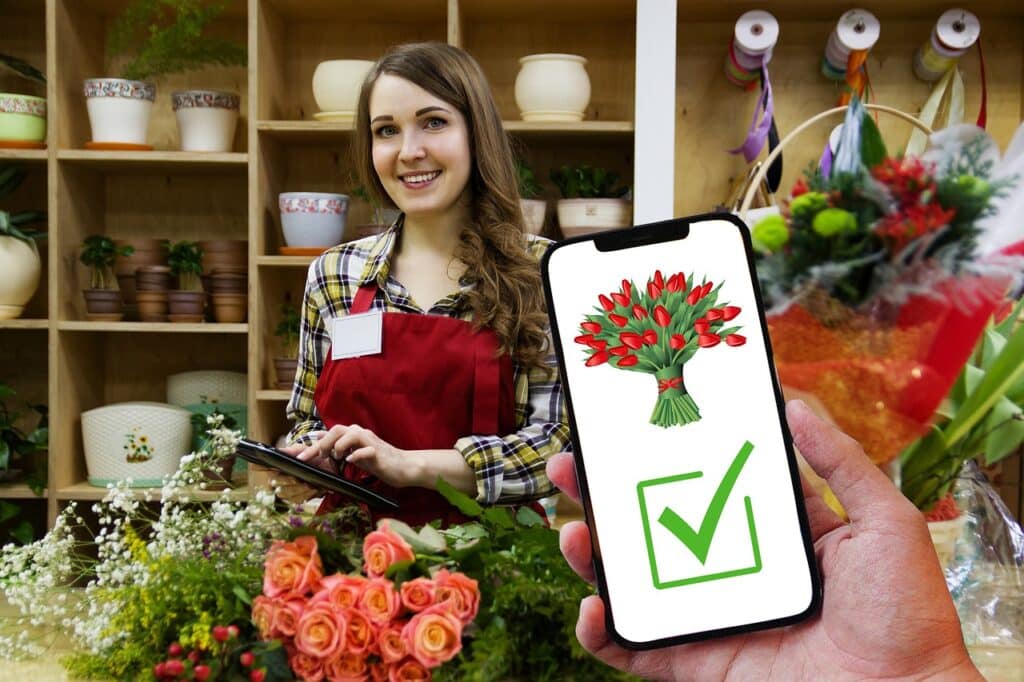
- Understanding how customers move through physical and online retail stores is essential to creating a good customer experience.
- Retail customer journeys are usually not linear; shoppers in a physical store behave differently than online shoppers.
- Customer journey maps should be specialized for retail environments. Choosing the right factors to map is critical.
- To create a good retail customer journey map, first identify the stages in the customer journey. Then choose what you want to measure. Finally, track the appropriate metrics and use the results to inform your understanding of customers’ paths to purchase.
What Are Customer Journey Maps?
A customer journey map is a visualization of how a customer moves through the stages from awareness to purchase and beyond. It includes information about what the customer is thinking, feeling, and doing at a certain stage as well as what their immediate and long-term goals are.
Most customer journeys can be divided into at least five stages:
- Awareness. The customer realizes they have a problem, desire, or need.
- Consideration. The customer researches ways to meet their need.
- Purchase. The customer makes their selection and finalizes their purchase.
- Post-purchase. This includes follow-up contact between the company and the customer, additional offers, troubleshooting, and customer service.
- Loyalty. When the customer is very satisfied with their experience, they become loyal customers or even brand advocates – someone who promotes your brand to others because they love it
While many retailers use standard customer journey maps, they may also need retail customer journey maps for specific areas, such as a customer’s path to purchase inside a physical store. In this article, we’ll focus on retail customer journey maps, especially the in-store variety. If you’d like to learn more about standard customer journey maps, read this article .
Customer journey maps offer a good way to match what a customer needs with where they are in their journey. In retail, these maps can also highlight disconnects between touchpoints, mismatched interactions, and gaps in the customer’s experience. It helps retailers connect the customer experience with customer motivations, unite fragmented areas, and adjust underperforming touchpoints.

The 5 stages in a customer’s journey.
Customer Satisfaction and the Retail Customer Journey
There’s a growing trend in business today towards customer-centricity . In its most basic form, this means keeping the customer’s needs and wants in mind at all times. But unless you correctly understand what the customer needs and wants at each given phase in their buying journey, you’ll struggle to meet their expectations.
Identifying Stages in the Retail Customer Journey
Optimizing the retail customer journey starts with understanding its stages. In a physical store, this means considering more than just how customers enter the store, choose an item, and checkout; it can also include how they get to the store and their movements inside it, as both of these factors influence what is purchased. In an online setting, the retail customer journey can be closer to the traditional customer or user journey.

Image by ElasticComputeFarm from Pixabay
It’s also important to understand who your customers are; you might be surprised how far this term reaches. Check out this article on identifying customers for more insight.
A Note About Retail Paths to Purchase
We want to emphasize that retail customer journeys are not linear; customers rarely proceed directly to the item they want to purchase, choose one, and complete their sale.
In an online store, they often look at competitors’ items, accessory items, and things that are completely unrelated to their original goal. In a physical store, customers may move from department to department, circle back, browse, change their mind, and so on. So, your customer journey path may have other points than the ones we’ve sketched out below.
A General Map of Retail Customer Journey Stages
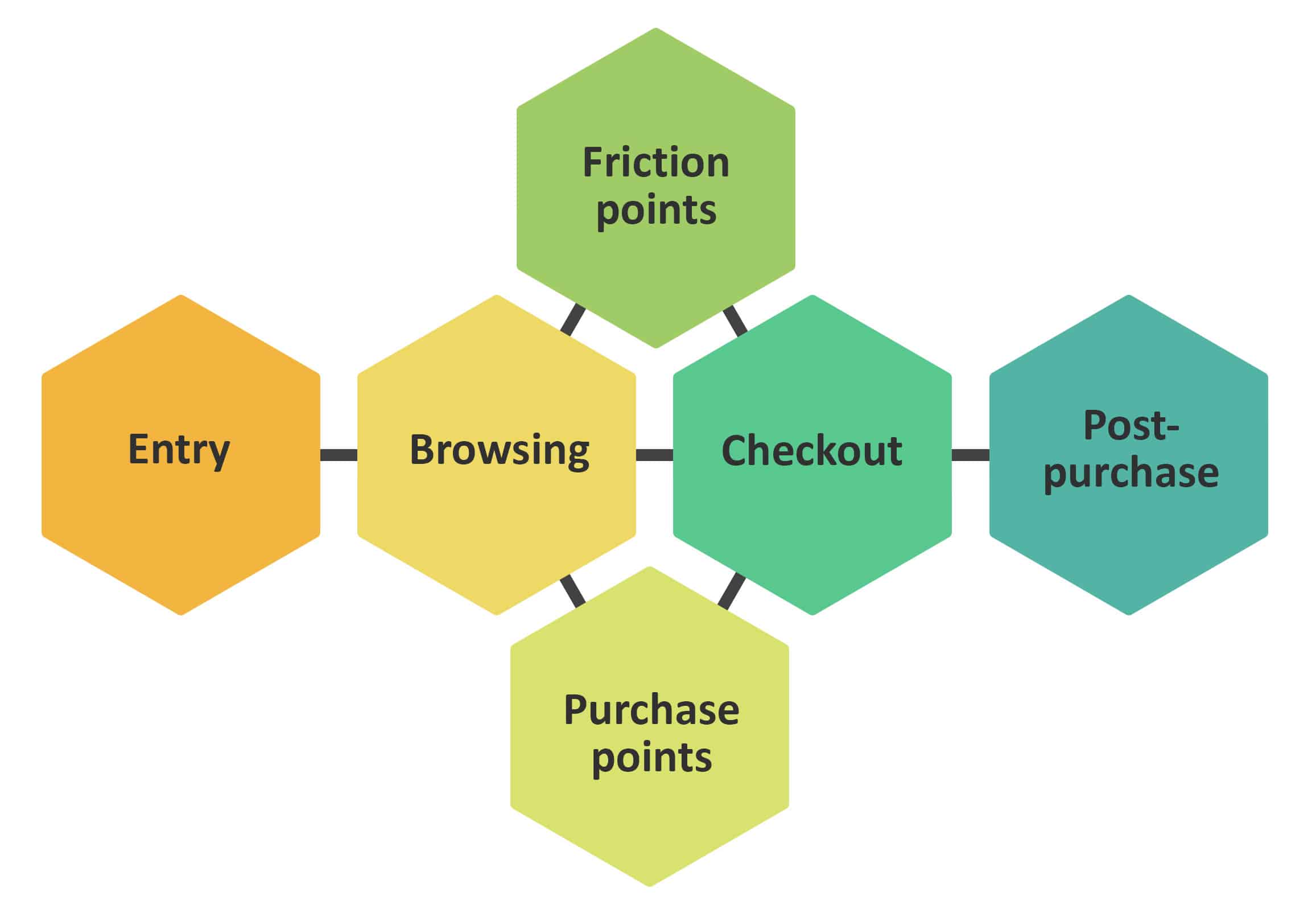
The stages of the retail customer journey.
For convenience, we’ve numbered these stages in the list below. Aside from the first and last stages, they may occur in a different order.
In a physical setting, this is when the customer enters the store. It also includes how they traveled to the store, the signage in the entryway and parking lot, etc. Online, this correlates with a person’s first visit to the website and the signup or login process.
As you’d guess, this deals with how people move around in the store: what they see, the employees they talk to, how items are displayed, informational signs, store layout, etc. In physical stores, this information includes foot traffic patterns, common customer paths, and other types of people tracking (individuals as well as groups). Online, it’s pretty much what the name suggests: how customers move through the website.
Purchase points
These are areas and times when a customer decides to buy a given product. In a physical store, there are multiple purchase points – i.e. when a person adds an item to their shopping cart, that’s a purchase point. These points can be influenced by employee interactions, end caps and product displays, packaging, signage, lighting, sound, and many other factors.
Friction points
These are things that prevent or slow the customer from reaching their goal. From a customer’s perspective, some might be classed as annoyances (long lines, slow website loading times, items out of stock, etc.). Both in online and physical settings, abandoning an order or item or taking a long time to complete a task is a good indication of friction.
Again, this is pretty much what it says on the tin. Potential factors in the physical checkout process include line length, time of day, number of checkout lanes, number of self-service checkouts, number of employees on duty, and even the season and weather. Online, we often look at the complexity of the checkout process; the longer and more complicated it is, the greater risk that customers will choose not to complete it.
Post-Purchase
Online and off, this includes customer service and satisfaction, surveys, follow ups, troubleshooting/returns, and the like.
Each of the above stages contributes to the customer experience and their buying journey. While post-purchase may seem like it’s a separate part of the retail customer journey, it’s essential to encouraging repeat customers. For more ideas, see this article on how retailers harness post-purchase experiences .
A Step-by-Step Guide to Creating a Retail Customer Journey Map
Creating visual representation of the path a person takes to becoming a retail customer can bring a lot of clarity to your business. It can fast-track retail optimization – highlighting improvement areas, helping you refine your marketing and advertising, and improving your internal workflows.
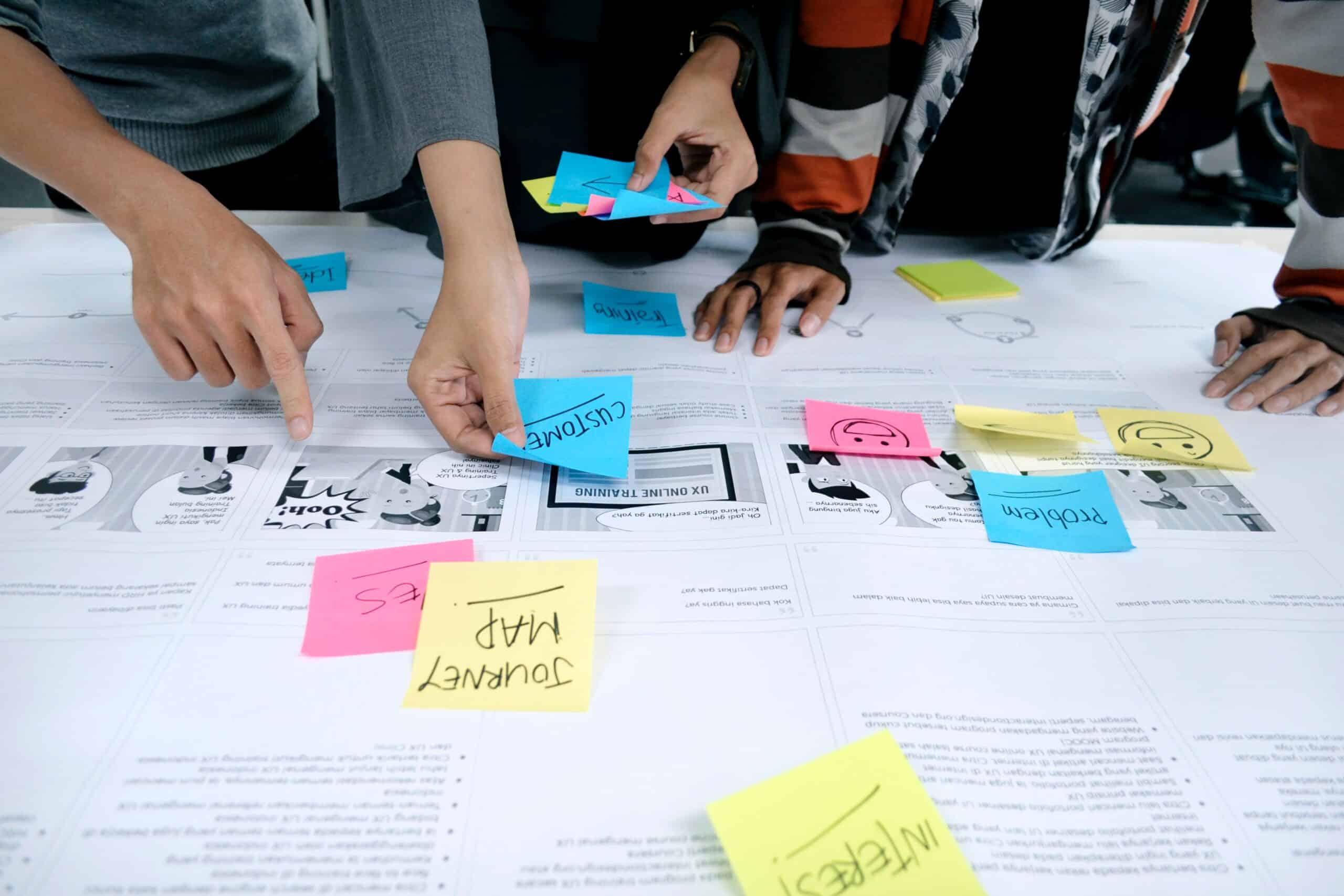
Photo by UX Indonesia on Unsplash
Ultimately, an accurate customer journey map can help you create satisfied, happy customers that keep coming back to your business. So, how do you go about making an effective map?
- Set goals. Why are you creating this map? What problem are you intending to solve? What information do you hope to gain? Understanding the answers to these questions will shape the information you gather, how you analyze it, and how you measure success.
- Choose key performance indicators. Once you know what your reasons and goals are, you can choose the metrics that shed light on those goals. For example, a retailer looking to find and minimize friction points might use the time it takes for a customer to complete an order as a key metric.
- Gather data. Next, find the information that’s relative to your needs. Be sure you choose accurate and reliable data sources; your retail customer journey map is only as good as the data it’s built on.
- Select a suitable map and template. There are many things that a customer journey map might portray: service time, time in store, product positioning, path analysis, local demand, etc. There are also many customizable, high-quality customer journey map templates that you can download and use for free. Your choice will depend on the factors we’ve just discussed.
- Dig into customer data. It’s tempting to focus on quantifiable data, but numbers rarely tell the whole story. You have to look beyond actions and think about what the customer is thinking and feeling at various touchpoints throughout their retail journey. And don’t underestimate motivation in the purchasing process; strong motivation can make customers overcome friction points that might deter less determined shoppers.
- Create customer personas. Use your findings to create detailed customer personas, which are fictionalized persons with the same traits as a group of customers. You can read more about customer personas and how to make them here .
- List all touchpoints. Any time your customer can do something that influences their experience or opinion of your business, that’s a touchpoint. In a retail setting, this can include product displays and signage, checkout lines, interactions with employees, email offers, ads, app notifications, etc.
- Map the retail customer journey. Trace the customer journey through the relevant touchpoints and experiences and record your findings in the customer journey map. If possible, you (or your company leadership) may want to take this journey yourself; it will give you a better idea of the actual customer experience.
- Validate and revise. Share your map with departments and workers that regularly deal directly with customers. Survey your customers about their shopping experience. Did you miss anything? Periodically revisit your map and make sure it still represents the entire customer journey; if changes need to be made, make them.
The Future of the Retail Customer Journey
Before we wrap up, let’s consider what will drive the retail customer journey for the coming years.
As in industries all over the world, AI and the digital revolution are going to be key players in the future of retail customer experience. In online shopping, AI has already made its presence felt in the realms of customer service (i.e. AI-powered chatbots that answer customer questions) and recommendation engines. It’s also used ubiquitously for data processing and analysis – both online and off; this has resulted in operational improvements and cost savings. Furthermore, we’re seeing AI expand into other areas of the customer journey, such as hyperpersonalization. Expect these trends to continue into 2024 and beyond.
Phygital Experiences: In a Store Near You

Image by thank you for 💙 from Pixabay
Even physical stores are experiencing the push towards a digitalized customer experience. For example, department store customers can shop in-store and scan items using the store brand’s app. This allows them to handle most of the checkout process and greatly reduce the time they spend in the checkout lanes, which means less congestion during busy times.
This is just one example of what’s known as a ‘phygital’ interaction – an interaction that takes place in the store but includes digital elements. Phygital (to say it, imagine you’re replacing the “d” in “digital” with an “f”) emphasizes a holistic approach to the customer experience and strives to seamlessly blend the digital world with the physical world.
Other important retail CX trends include authenticity and socially-conscious consumerism; you can read more about it in Bernard Marr’s excellent article . And while we’re fascinated by the ways technology can make the retail experience better and smoother, we also encourage you to remember that technology has to serve humans . In other words, it has to meet customer needs and make sense for the humans using it. As the retail customer journey incorporates more digital touchpoints, we have to ensure that humans are always at the center of our decisions.
Crafting the Perfect Retail Customer Journey
Understanding how and why customers make the choices they do is crucial to creating the best possible retail customer journey. A customer journey map that’s geared towards retail experiences – whether in a physical store, through an e-commerce site, or as a blend of the two – is an essential way to build understanding and empathy for your customers.
Contact CX by Design today to better understand your retail customer’s journey. Schedule your free 30-minute consultation here . We have over 20 years of experience in crafting great customer experiences, we’re uniquely qualified to help you connect with your customers in a meaningful way.
- customer experience
- customer journey in retail
- Customer journey retail
- retail customer experience
- Retail customer journey
Sign up for the CX by Design Newsletter to stay up to date!
You have been successfully subscribed! You can find out more about how to work with us on our site OR reach out to us directly if you want to chat.
Lis is an acclaimed design and strategy thought leader, writer, and speaker with extensive expertise in Digital Strategy, Customer Experience, Information Architecture, and Design Thinking.
- November 21, 2023
- November 1, 2023
- September 27, 2023
CX Circle London is here to help you level up your game → Secure your spot on June 13
- Beauty & Cosmetics
- Financial Services
- Miscellaneous
Decoding the Retail Customer Journey: A Detailed Approach and Best Practices

Marie Jehanne
September 4, 2023 | 3 min read
Last Updated: Oct 17, 2023
Table of Contents
What is a Retail Customer Journey?
Why is understanding the journey important, key phases of the retail customer journey.
The retail customer journey , a critical concept in ecommerce and retail marketing, refers to the series of interactions a customer has from the initial product discovery to post-purchase experiences.
This process, influenced by consumer behavior, is not linear but a complex web of touchpoints across multiple channels and devices. It includes pre-purchase research, comparison shopping, the purchase decision, and post-purchase experiences. Understanding this journey is vital for retailers looking to optimize their sales funnel and drive sales.
Through a detailed analysis of the customer journey, retailers can identify key touchpoints, understand customer behavior, and tailor their product display and offerings to meet customer needs at each stage of the journey.
The retail customer journey is a comprehensive overview of consumer behavior and interaction with a brand or product. It encapsulates every step from the initial discovery to the final purchase decision and even post-purchase interactions.
This journey is not just a path to a transaction, but an insight into the customer experience with a brand. The retail customer journey is often segmented into stages such as awareness, consideration, and purchase, ending with brand loyalty. Each stage represents a different point in the customer’s interaction with your brand, and understanding these stages can help you better cater to your customers’ needs and expectations, thereby improving customer satisfaction.

See how your digital experience stacks up. Download the 2024 Retail Digital Experience Benchmark Report for the metrics that really matter.
Understanding the retail customer journey is crucial for several reasons. Firstly, it provides valuable insights into consumer behavior, preferences, and needs. This information can be used to optimize retail marketing strategies, improve product offerings, and enhance the customer experience. Secondly, understanding the customer journey can help retailers identify opportunities for growth and improvement.
By analyzing the customer journey, retailers can pinpoint areas where they are losing customers, identify gaps in their service, and implement strategies to improve customer retention and satisfaction.
Understanding the customer journey can help retailers build stronger relationships with their customers. By understanding their needs and preferences, retailers can provide personalized experiences, build trust, and foster brand loyalty. This not only improves the customer experience but also drives repeat business and customer advocacy.
How to Create Customer-Centric Advertising Campaigns in 2021
The retail customer journey is a pivotal component of retail marketing, incorporating several key phases that reflect the consumer behavior. Each phase signifies a unique interaction point between the customer and the retailer, presenting opportunities for engagement, influence, and customer retention. Comprehending these phases is essential for retailers, as it enables them to customize their marketing strategies to cater to the specific needs and preferences of their customers at each stage of the sales funnel.
The awareness phase is the initial stage in the retail customer journey where potential customers become familiar with a retailer or their products. This can transpire through various channels such as ecommerce platforms, online advertisements, word of mouth, or direct marketing. The main objective during this phase is to pique the interest of potential customers, establishing brand recognition, and fostering brand loyalty.
The consideration phase ensues the awareness phase. This is a critical phase in the customer journey, as customers begin to evaluate the retailer’s offerings against those of competitors. They compare product display, prices, customer reviews, and other relevant factors. The goal during this phase is to position the retailer’s offerings as the most attractive option, influencing the customer’s purchase decision and enhancing customer satisfaction.
The decision phase is the final stage where customers make their ultimate purchase decision. Providing a seamless and positive customer experience during this phase is critical, ensuring the process of making a purchase is as straightforward and convenient as possible. This can be achieved by offering multiple payment options, providing clear and detailed product information, and delivering excellent customer service, thereby boosting customer satisfaction and fostering customer retention.
Stay updated
and never miss an insight!
Passionate about digital for several years, I am the Inbound Content Manager SEO at Contentsquare. My goal? To teach you how to improve the digital CX of your website and activate the right acquisition levers to generate more traffic on your site and therefore…more sales!
Keep Reading...

Digital experience in insurance: Selling the steak, not the sizzle
Contentsquare
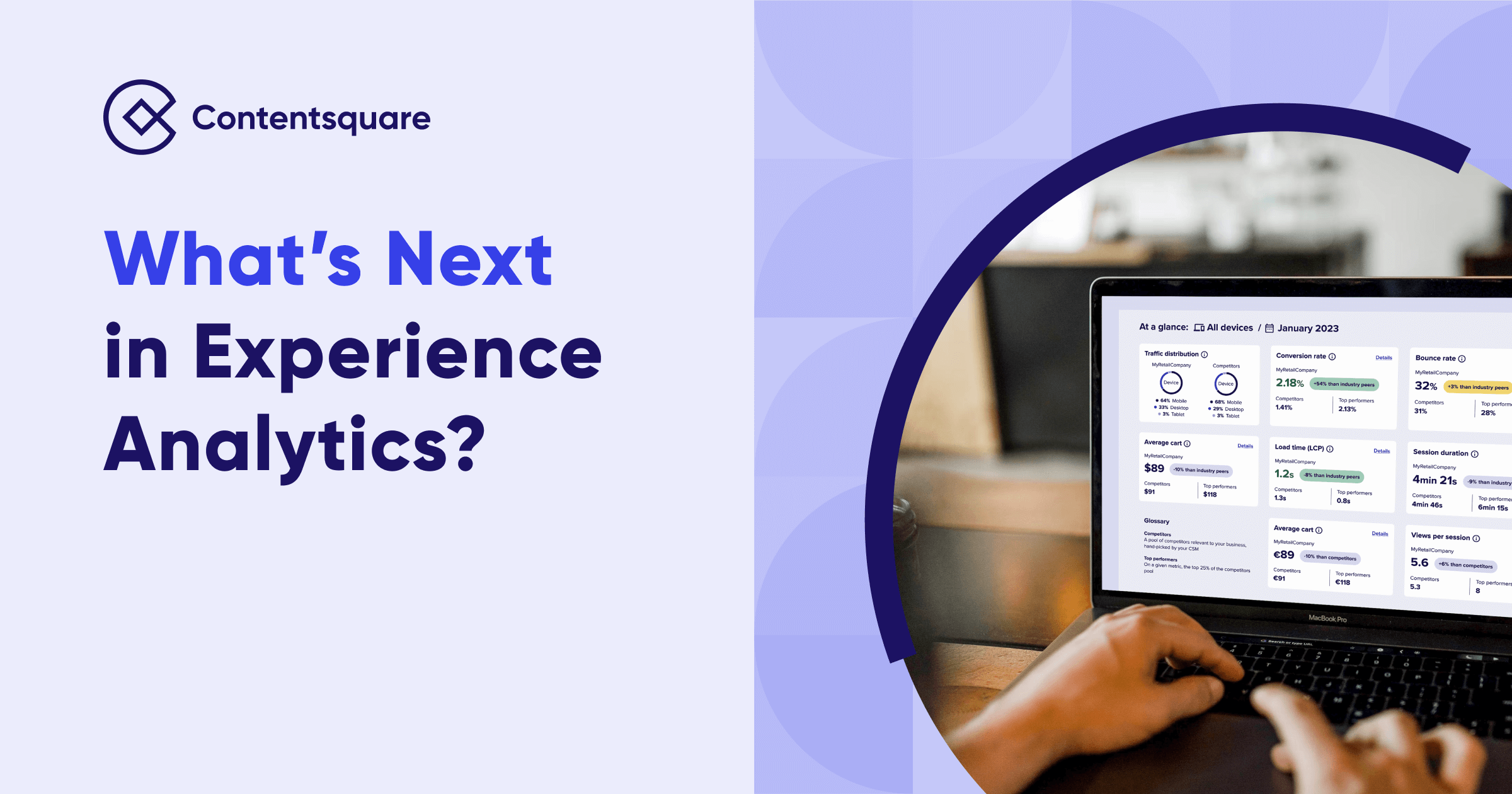
What’s Next in Experience Analytics?
Lucie Buisson

- Uncategorized
All you need to know about the SDR role at Contentsquare
Virgine Guerrero, Director of Sales Development

Home » Blog » Creating A Customer Journey Map: Best Practices For Retail Brands
Creating A Customer Journey Map: Best Practices For Retail Brands

We understand the importance of our customers’ thoughts and ideas, but what does your brand do to effectively build a customer journey map?
In today’s hyper-competitive landscape, it’s all about learning from our customer interactions before, during and after the sale. The problem is we often make erroneous assumptions that don’t align with our customer’s reality.
Additionally, it’s easy to fall behind on meeting our constantly growing customer expectations and meeting them with a great and ever-changing customer experience .
Your customer journey map describes your customer’s path from the moment your brand enters their awareness through the in-store experience, purchase and post sale. Creating a customer journey map gives you a high-level overview of all of the touchpoints between brand and customer.
Customer journey maps increasingly appear in omni-channel initiatives to ensure the customer experience is consistent across all channels. Mapping out these journeys are invaluable to marketing and customer experience efforts.
But all too often, brands and retailers attempt to understand customers and don’t learn true and valuable frustrations. It’s easy to make assumptions that don’t align with our customers’ reality.
Instead, we have a lot of data about our customers’ experience, but have no way to put the insights into action.
Addressing the Long-Term Customer Journey Map Solution
Retail is relatively stable over the short-term. Brick and mortar stores and the majority of customers aren’t going to disappear in the next year or two. The National Retail Federation even expects a rise of 4.1% in holiday retail spend compared to the previous year’s 3.5% growth. Over time, it will become apparent which brands and retailers decided to tackle the hard questions.
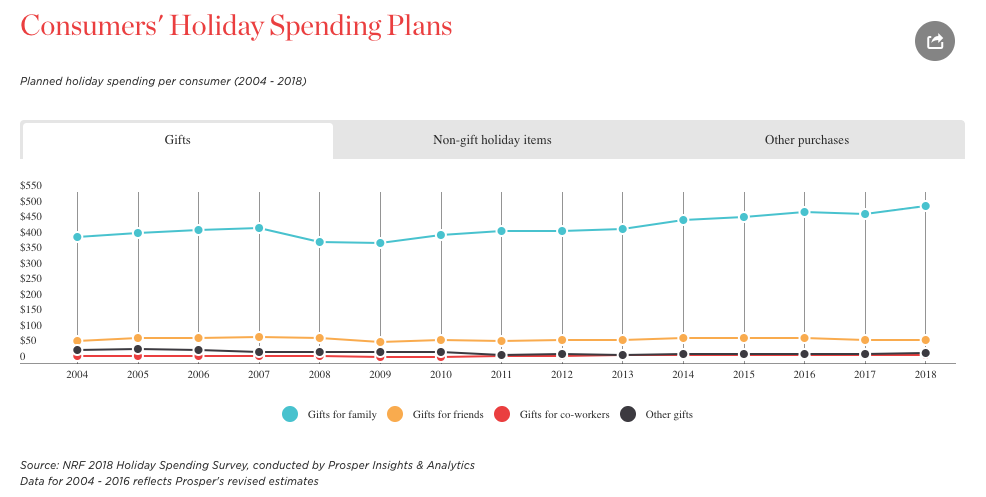
To understand how we can drive brand innovation through the adoption of up-to-date best practices, let’s investigate the process of modern customer experience design, starting with the customer journey map.
Planning Out the Customer Journey Map
To make this easier, we made up a fictional 500-store business called David’s Doors–a retailer selling commercial and residential doors–to plan our customer journey map. Its typical customers are building owners and contractors and we know they sell doors in stores and BOPIS (buy online, pick-up in store).
This company also sells hardware for doors and door installation services. David’s Doors average daily revenue per store is $5,000 and concerned with stagnating sales, they’ve recently commissioned an internal project team to create a customer experience report.
As part of this report, the project team generated a customer journey map:
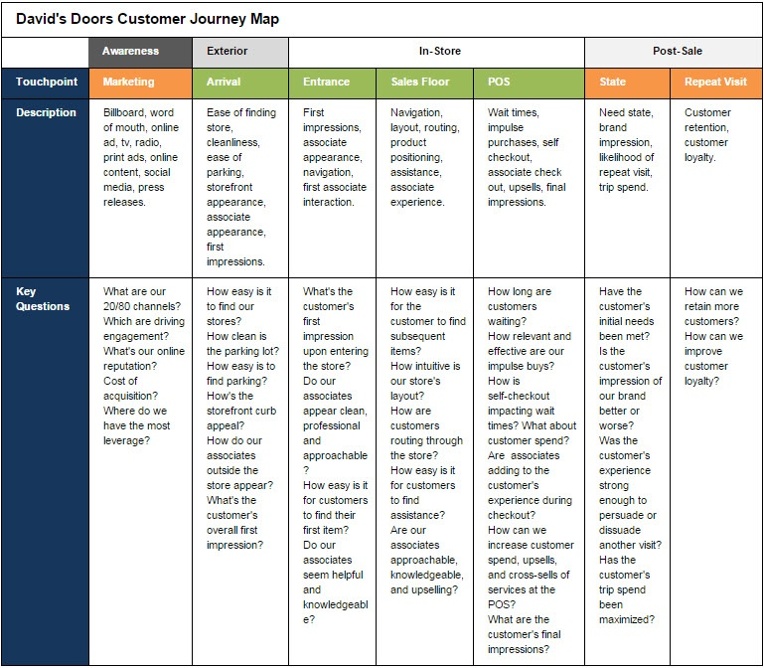
The customer journey map details the customer’s experience beginning with their brand awareness, through the purchase process and post-sale. During the discovery process, the project team generated a list of key questions regarding the current customer’s experience.
As a result of these inquiries, the project team generated a list of recommendations for best practices moving forward, based on the project team’s research into innovators within the industry and industry leaders.
Best Practices for Retail Brands
From a marketing and customer experience perspective, the shift occurring for retail is best described as a sliding scale between driving procedural efficiency and driving customer acquisition and retention. In the traditional retail paradigm, marketing and customer experience campaigns are implemented on a region-by-region and store-by-store basis.
Additionally, these campaigns are based on segmented lists and past data. In the new retail paradigm, marketing and customer experience are implemented on a customer-to-customer basis and based on individual customer data.
Modern marketing is agile and testing is done on shorter cycles with immediate feedback. Highly targeted messages are delivered to individual customers based on their personal data history and through their preferred mode of communication.
Modern customer experience delivers highly personalized experiences and gives the customer the power to define their shopping experience. With online retail trying to outpace brick-and-mortar and customers’ increasing expectation to define their personal shopping experience, brick-and-mortar retailers face increasing pressure to elevate their brand equity and become and remain their target market’s preferred retailer.
The challenge large retailers face is how they can implement this data and the data from their customer maps at scale while also planning to meet their customers’ future needs.
To tackle this challenge, your implementation must be tested thoroughly. The best ways to test your implementation are through customer surveys and mystery shopping programs. Together, they deliver the required data needed to identify problems and ensure that you have captured the customer journey map as your customer experiences it.
Related Posts

- Get Newsletter
7 Actionable Analytics for In-Store Customer Journey
- 10 Comments
- 15 min read
What’s In-Store Customer Journey?
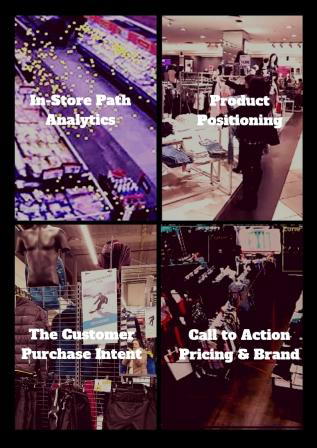
The In-Store Customer Journey is a dynamic map that tracks how people behave in a physical store. The analytics generate actionable insights to increase conversions and optimize profits.
Using case studies as examples, here are projects you can start today:
7 In-Store Customer Journey Examples
- Identify Purchase Points
- Map Path Trajectory
- Quantify Local Demand
- Prevent Friction Points
- Measure Engage Time
- Monitor Service Time
- Optimize Product Positioning
Let’s start with definitions.
What’s In-Store Customer Journey Map?
An in-store customer journey mapping visualizes the shopping funnel from entering a retail store to checkout. In other words, an in-store customer journey map describes the transformation from “visitor” to “buyer.”

What are Actionable Insights for In-Store Customer Journey?
Actionable insights make you rethink the where, what, and why of in-store customer behaviors. The analytics describes the building blocks of the In-Store Path to Purchase.
Technically, people-tracking technologies capture objects using detection , recognition, and tracking “people in motion.”

The (anonymous) foot traffic data and object attributes generate actionable metrics for retail stores, shopping malls, and other physical environments.
The in-store customer tracking data includes:
- Location to understand local demand opportunity.
- Time to evaluate the shopper’s “intent to buy.”
- Touchpoints to track in-store customer engagement.
- Attributes to identify visitors and shopping groups.
- Behaviors to manage customer service and improve customer experience.
What are the Steps to Design an In-Store Customer Journey Map?
Contrary to online purchase funnels, the in-store customer journey is dynamic. In other words, the process is not a step-by-step linear sales funnel but robust retail KPIs.
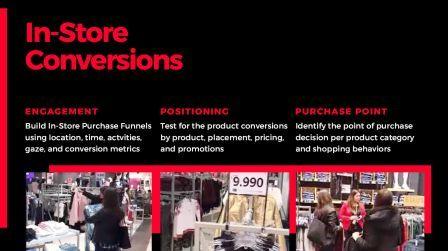
Moreover, the in-store customer journey isn’t only for individuals. In physical stores, you also need to take into consideration the actions of employees and groups.
Design the In-Store Customer Journey Step-By-Step
Here’s my process for designing the in-store customer journey:
PEACE Method for Profit
- People : identify customer behaviors
- Engage : measure shopping activity
- Abandon : prevent friction points
- Conversion : Pinpoint the call to action
- External : Optimize retail KPI
The dynamic mapping of customer and staff behaviors will help you understand the transformation from browsing to buying.
3 Sources of Confusion about the Customer Journey in Retail
The Covid-19 pandemic accelerated the “digital transformation” of physical stores.
People Now Spend More at Amazon Than at Walmart New York Times
And yet, confusion is prevalent.
For example,
1) Online vs. Offline Shopping Behaviors
Retailers and marketers often talk about “seamless retail analytics.” And yet, to build a customer journey map correctly, you focus on behaviors in physical locations.
There are distinct differences between online and offline shopping.

Linear vs. Dynamic Maps: Online behaviors are dictated by how people move from webpage to webpage (impressions and clicks). In physical stores, you cannot dictate customer flow. The in-store sales funnel is not linear but dynamic.
Sole vs. Social Visits: Online, people buy for themselves or someone else. As a result, the online sales funnel is for individuals. Physical stores are social. The in-store customer journey should consider the impact of associates and groups.
Conversion vs. Profit Goals: Conversion Rate Optimization (CRO) is a defined discipline for online commerce. CRO exists because digital products are hard to create but easy to duplicate. But physical locations suffer from the multiplier effect. Therefore, in physical stores, the outcome is not conversions or sales but profits.
In summary, you should assume the offline customer’s experience is NOT the same as online shopping behaviors. It reflects on the in-store customer journey.
Our research found that one consequence of the new world of marketing complexity is that more consumers hold off their final purchase decision until they’re in a store. McKinsey & Company
2) Anonymous Behaviors vs. Personalized Marketing
Another source of confusion is the difference between marketing personalization and the anonymous tracking of in-store customer behaviors.
That’s the difference between location-based marketing and location analytics.
Technically, that’s a data attribution challenge. Data attribution refers to the process of crediting sales and conversations to specific customers and their behaviors.
Here’s what you should know:
Exactly like it sounds,
Location-based marketing is about sending personalized push notifications to consumers based on their geophysical location.
Location Marketing refers to device-based personal trackers that emit location-based data. In other words, devices such as smartphones represent a gateway to individuals.
Location-based marketing requires consumers’ opt-in. And retailers can connect directly only with consumers in their loyalty applications.
But if your focus is the store, the data can be anonymous.
Location Analytics depends on object detection and people-tracking technologies. The data output is anonymous. You don’t need to identify the object (person). You only need to know the object’s location, attributes, and behaviors.
The business benefits include geo-location demand analytics, foot traffic data, and tracking in-store consumer behaviors.
Location analytics is the technical framework beyond in-store optimization.
The goal is not to interact digitally with consumers during their visits to physical stores. The objective is to improve store operations and customer service.
For example,
Customer segmentation and personalization serve different business goals. With segmentation, you design the store. Personalization is about marketing promotions.
Even at the highest levels, retailers don’t really understand either the rewards or the risks associated with anonymous vs. non-anonymous customer geo-location data. RSR Research
3) ROI is a function of Product, not Technology
Often there’s confusion between the technology and product.
Technology is the building block. For example, you could track customer behaviors with Smart Cameras or a cloud-based engine using CCTV feeds.
A product solves a user’s problem. For example, Queue management is for store managers. Contactless checkouts are self-service for shoppers.
You can have an excellent solution to a specific problem even with simple technology. What matters is that you solved a problem for a user.
You start with clarifications.
In Behavior Analytics, terminologies have a technical definition.
- Visitor: a person entering the physical store
- Consumer: the end-user of the product
- Buyer: the person who pays
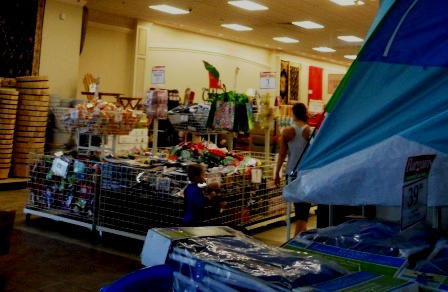
And in the case of groups (two or more people):
- Buying Group : a group with a single buyer, for example, a mother and daughter
- Shopping Group : two or more buyers, for example, two girlfriends
- Service Group : the interaction when an employee helps a customer
To design the map, you can start with the methods from the online customer journey . The next step is to combine the tracking data into an “actual” motion inside the store.
Each time a consumer is exposed to an improved shopping experience, their expectations are reset to a higher level of experience. Brendan Witcher, VP Forrester
In-Store Customer Journey Analytics You Should Start TODAY
You are now ready to build a data-driven map of customer behaviors.
Let’s dive in.
Example 1) Identify Purchase Points
Purchase Point is the event where in-store visitors decide to buy.
In other words, the Purchase Point refers to the WHERE & WHEN the shopper decided to buy the product. It’s the “one step before the checkout process” in physical stores.
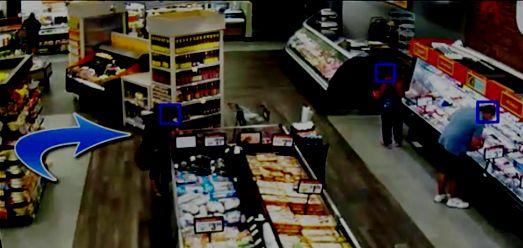
Purchase Points are distinctly different from online purchase decisions .
- Supermarkets: when a customer puts an item in the shopping cart
- Department stores: when a customer tries samples from the makeup counter.
- Digital fitting rooms: the Purchase Point and Checkout merge into a single location because the customer can do both with Smart Mirrors .
The dynamic map captures the Purchase Points using location, time, and behaviors to clarify why people buy.

Example 2) Map Path Trajectory
Path Analytics, Customer Flow, and Path Trajectory are different names that describe how people move inside a physical location.
Often, the outcome is a Heat Map. You see different colors that represent different levels of occupancy per period.
While visually attractive, Heat Maps are not operational.
To be actionable, Path Analytics provides information on local foot traffic patterns. It requires data on object trajectory.
- Entry: How many people entered a specific virtual location
- Exit : How many people left a specific virtual zone
- Real-Time Occupancy : How many people are inside a virtual zone in real-time
Example for Path Analysis
Store Layout: Path Analytics paints of picture of how people move inside a physical location. For example, IKEA stores have a pre-defined path. So do museums. The data confirms whether people move inside the physical location as planned.
Big Box Stores: There are stores-within-stores in Big Box Stores such as department stores and Do-IT-Yourself stores. For example, a L’Oreal beauty counter or a Samsung store in Target. With Path Analytics, the customer flow data illuminates the relationship between brands and retailers.
Aisles & Islands: With Path Analytics, you can drill deeper into the in-store design. For example, you can track customer behaviors in aisles, islands, and display fixtures. In other words, you’ll learn more about how people find a specific product.
Path Analysis is helpful to understand the customer’s flow in any physical location, including retail stores, airport hubs, and shopping malls .
Once you mapped how people move inside the physical store, you analyze specific touchpoints.
Example 3) Quantify Local Demand
Occupancy is one of the most versatile and least appreciated retail metrics. It means the number of people staying within a virtual zone per period.

In other words, Occupancy describes “Local Demand.”
- Real-Time Occupancy is the number of people inside the store right now
- Occupancy reflect the actual sales opportunities for products in the zone
- In optimization tests, Occupancy can be an outcome metric or top of funnel
Examples of Local Demand
- Increased Density : Before the American holiday of the 4 th of July, there’s a significant increase in demand for specific products such as meat and corn. The metric of Occupancy provides insights if the store maximized the sales opportunity.
- On-Site Scheduling : Evaluating the impact of assigning an expert associate to work as a cashier during heavy traffic. In other words, you measure which job has more effect on customer service and customer satisfaction.
- Customer Engagement : Measure the correlation between local foot traffic and customer engagement. For example, evaluate the better placement for a coffee station. One option is in a high-occupancy area of frozen meat and fish. A second option is in the less dense deli area.
Occupancy provides quick insights into core assumptions about store layouts and design.
Example 4) Prevent Friction Points
Abandons, bottlenecks, and checkouts create obstacles to the shopping process and the customer’s experience.
Queue Management & Checkouts
The most known friction point for in-store shopping is checkout.
Back in 2010, Kroger Supermarkets deployed the original Queue Management System. It reduced the average waiting time from 4 minutes to 30 seconds and increased sales by almost 2%.
In 2017, Amazon launched the first contactless store, Amazon Go.
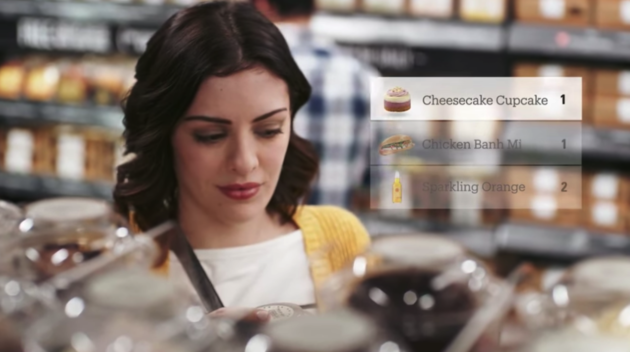
Examples of Queue Management
- Queue Management (Last Touch): for example, preventing queue formation by optimizing the number of active cashiers in supermarkets.
- Queue Flow (First Touch): in limited resources, you monitor customer service by queue speed, for example, in Quick Service Restaurants (QSR).
- Self-Service Kiosks: monitor customer engagement and staff service for compliance with self-service payment policies.
- Scan & Go : using devices for self-payment, for example, mobile pay and Smart Carts. The advantage of Scan & Go is the relative simplicity of the solution because it depends on usage by shoppers.
- Touchless Self-Checkout : There is the end-to-end touchless customer experience model, such as the Amazon Go stores. There are also touchless solutions only for payment and checkout, such as self-service tablets in Starbucks.
Always migrate your audience to the path of least resistance. Kintan Brahmbhatt, Amazon
Examples of Abandon Behaviors:
Abandon behaviors have an indirect but significant impact on the customer experience.
- Abandon Activity : for example, people leaving the line to the checkout.
- Not Starting Activity: for example, not using counter service at lunchtime
- Not Entering the Store : for example, not entering bank on the 1 st of the Month
- Not Returning to Store : for instance, people remember “bad service” and avoid the store in the future. Worse, they tell their friends.
With a dynamic map of the in-store customer journey, you evaluate policies, procedures, and processes. You will find clarity on the impact of the friction points on the customer’s experience and sales.
Next, let’s turn to customer behaviors.
Example 5) Measure Customer Engagement Time
Customer engagement is a critical component of in-store optimization.
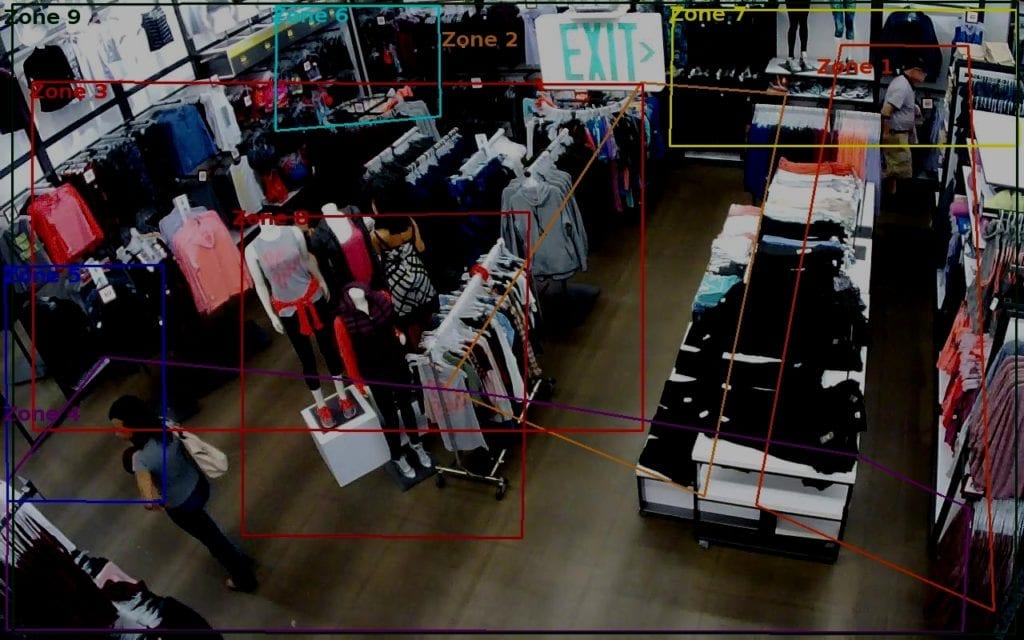
Technically, the analytics of in-store customer engagement depends on:
- Tracking anonymous object behaviors within a virtual zone
- Personal tracking of wireless devices across the physical location.
- Deploy advanced analytics to combine object tracking, device signals, and object attributes from imaging technologies.
The people-tracking technology and infrastructure influence data quality. That will have a direct impact on what you can do.
Examples of Customer Engagement Time
Time-based metrics have different definitions, but the duration of time is a strong signal of customer engagement.
Engagement Threshold: Set the minimum level of engagement time. For example, in an apparel store, the engagement threshold for black pants was 20 seconds. For premium-priced shirts, the engagement threshold was 40 seconds.
Optimal Engage Time: Identify the most effective customer engagement time. For example, optimal time in front of a cosmetics display in a beauty store is 15 seconds to 90 seconds. In the makeup counter, an optimal time is above 60 seconds.
Time-based metrics for customer engagement are by retail sector and product category. And the evaluation of duration depends on the local environment.
Example 6) Monitor Service Time
What’s the value of an excellent salesperson?
If you ever walked into a retail store with the intent to spend $20 and left with sales of over $1000, you know what I’m talking about.
Telecom companies, for example, have an Optimal Service Time to sell their phone and internet plans. And they design their concept stores accordingly.
Fashion stores also benefit from Optimal Service Time. For example, 20 to 50 seconds of service time that includes a quick hello and pointing to the correct aisle proved to have to most impact on sales.
Service is a critical component in the success of physical stores. Just ask Best Buy .
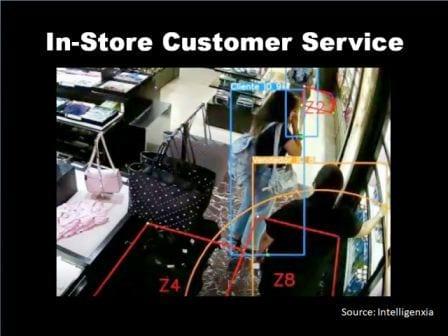
How do you measure Service Time?
Service Time is the duration of the interaction between an employee and a customer.
- Structured Customer Service, such as counter service in a deli
- Roaming Sales Associates, such as selling jewelry or electronics
- Ad-Hoc Encounters that exist in no-touch dept stores.
Together with Service Intensity and Service Productivity metrics, Service Time plays an important role in evaluating labor productivity.
Example 7) Optimize Product Positioning
Product Positioning includes position, placement, pricing, and promotions of items in a physical store. You can visualize product positioning with planograms.
These factors impact the sales conversion of the product category and specific items.

Clearance Racks: you can optimize the duration of premium products by tracking customer behaviors around prominent displays and regular aisles. You increase profits by reducing the number of items moved to the clearance racks.
Staff Expertise: In certain products – such as jewelry, electronics, and even construction – the availability of an expert associate makes a considerable difference in sales
End Cap Positioning : Brands tend to pay extra for positioning their products in high-traffic end caps. Here’s a hard truth – a high volume of traffic does not necessarily mean customer engagement.
It’s not enough to know what people needs and desires are. We also need to know how that interacts with the store’s environment. Ted Burkes TED Talk
The Advantages of In-Store Customer Journey Dynamic Maps
If you watched over 1,000 hours of customer behavior videos like me, you know that people always surprise you. Always!
With technological advances of AI, Vision, and Cloud, solution providers can generate in-store customer journeys in real-time.
- Supermarkets can evaluate product categories and product trends
- Stores can track the offline to online onboarding of Smart Walls
- Mall management can measure the impact of promotions on foot traffic in real-time
With live maps, retailers, brands, and mall managers can optimize their physical locations with the techniques of in-store optimization.
Start today.
- English Tiếng Việt Bahasa ไทย 中文 عَرَبِيّ KOREAN
- ETP #Futuretail
- ETP at HIPPINDO, Modern Retail Expo 2017
- Life at ETP
- Management Team
- API Management
- Artificial Intelligence
- Benefits of Omni-channel V5.5
- Career Form
- Carrom Tournament 2023
- Challenges of Omni-channel Retail
- Christmas 2023
- Cookie Policy
- Cricket 2023
- Customer Relationship Management
- Customer Testimonials
- Diwali Celebration 2023
- Download Document
- Downloads Page Contents
- e-commerce, elevated
- eCommerce Solutions
- Elementor #11229
- Elevating Retail Performance
- Employee Testimonials
- ETP #Futuretail India 2017
- ETP #Futuretail Indonesia 2017
- ETP #Futuretail Indonesia 2018
- ETP #Futuretail Malaysia 2019
- ETP #Futuretail Philippines 2018
- ETP at ETRetail 2023 as Omnichannel Technology Partner
- ETP at Hippindo, Modern Retail Expo 2019
- ETP at IRS 2023 as Ruby Sponsor
- ETP at NRCE 2022 as Platinum Sponsor
- ETP at NRCE 2023 as Platinum Sponsor
- ETP at PRC 2022 as Omni-channel Partner
- ETP at PRC 2023 as Retail Technology Partner
- ETP at ReTechCon 2017
- ETP at ReTechCon 2018
- ETP at ReTechCon 2019
- ETP at RLS 2017
- ETP Cloud POS & Retail Operations
- ETP Copyright Terms of Use
- ETP Health Camp
- ETP Privacy Policy
- Events section 1
- Events Section 2
- Events section 3
- Independence Day 2023
- Logistics Management
- lp-template-1
- Manage your queues better with user-friendly mPOS solutions
- Marketplaces & e-Commerce Integrations
- Mobile Applications
- Navratri 2023
- new page to make live
- new page to make live 2
- Omni-channel for E-commerce
- Omni-channel Fulfilment
- Omni-channel POS software
- ETP Omni-channel Retail Solutions deliver the following benefits:
- Omni-channel vs Multi-channel
- Omnichannel Retail Software Company
- Our Customers
- Awards & Certificates
- Case Studies
- Demo Videos
- News & Archives
- Whitepapers
- Our Solutions
- Partner Testimonials
- Alliance Partners
- Become a Partner
- Business Partners
- Connect With ETP Business and Alliance Partners
- Product Information Management
- Promotions Planning software
- Proven Retail POS Software
- Republic Day, India
- Retail Customer Relationship Management Loyalty
- Retail Inventory Management Solutions
- Retail Store Software Provider
- Search Results
- Implementing Solutions
- Support you can count on
- Smart Order Management
- Thank You Career
- The Journey to Creating Amazing Customer Experiences
- The Key Pillars of Omni-channel Success
- Tomorrow’s Business, Transformed Today India 2024
- Top Benefits of mPOS Technology
- Understanding Omni-channel Retail better
- Unified Inventory Management
- Unified Promotions Management
- Video Testimonials

It is of prime importance for retailers to track the retail journey of their customer in order to make the right moves and provide better customer service. It gives them an opportunity to align their strategies effectively to the customer journey road-map. Given the latest developments and innovations in retail, the customers of today are spoilt for choice and options. All this seems to make the customer journey very complex, however it can be construed that the journey traverses 5 fundamental stages.
Research – The trigger to every purchase is the intention to acquire that particular product that is desired or needed. This leads the customers into the first stage of the journey, which is research. They research the various aspects of the desired product such as its cost, features and specifications, alternatives and so on through means and methods available. Additionally, they also research about the retail companies offering these products thus making it important for the businesses to have an omni-channel presence, be relevant and have an edge over the competition when the customers are researching.
Identification and Consideration – Once the research is over, customers analyze the information they have gathered. Based on their inferences, they narrow down their options for the product as well as for the retailer from whom they intend to procure it. Further, they compare the options they have narrowed down to and consider the one that they feel is the best. The impact that the retail businesses manage to cast during the customers’ research will decide whether they fall into the consideration bracket of the customers or not.
Transaction – This is where the customer acquisition is realized. It is at this stage where the actual purchase happens – the customers buy the product and pay the stipulated amount for it. Though it looks like a simple process of give and take between the retail businesses and the customers, it is not merely that. There are other aspects that make the process complicated and critical leading into the next stage.
Experience – From the customers’ point of view, if the transaction process was simple, easy, engaging and left a positive influence, it can be said that they have had a good experience. This is very important for the retail businesses as customer experience is one of the key ingredients in establishing a retailer-customer long-term relationship.
Retention – After establishing the relationship with the customers, the retail businesses need to build on it further. The longevity of this relationship could very well be the ability of the retailers to retain and extract more revenue from the existing customers. Thus the criticality lies in not only delivering the right experience in terms of deliverables and processes, but also sustaining those efforts and even exceeding the expectations at times. This will help foster loyalty among the customers and build goodwill through positive word-of-mouth, which the retail businesses can benefit from.
So is your retail business making the right impact at every stage of the customer journey?
Related Posts
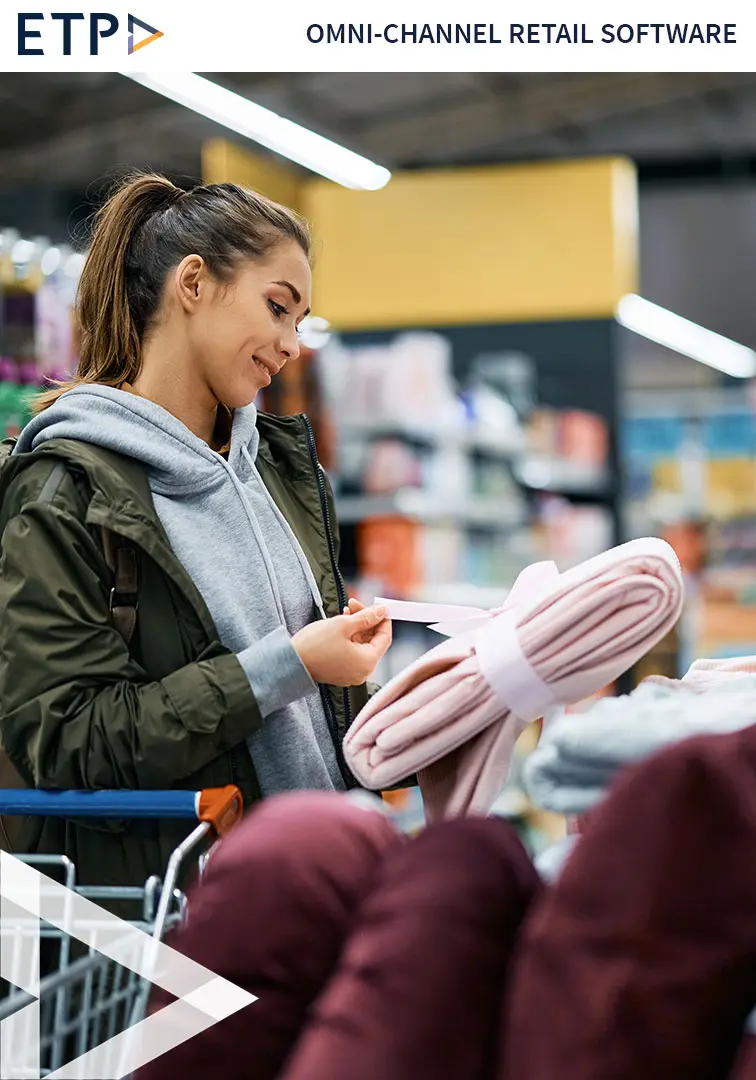
How to Implement an Effective Omni-Channel CRM Strategy for Your Business
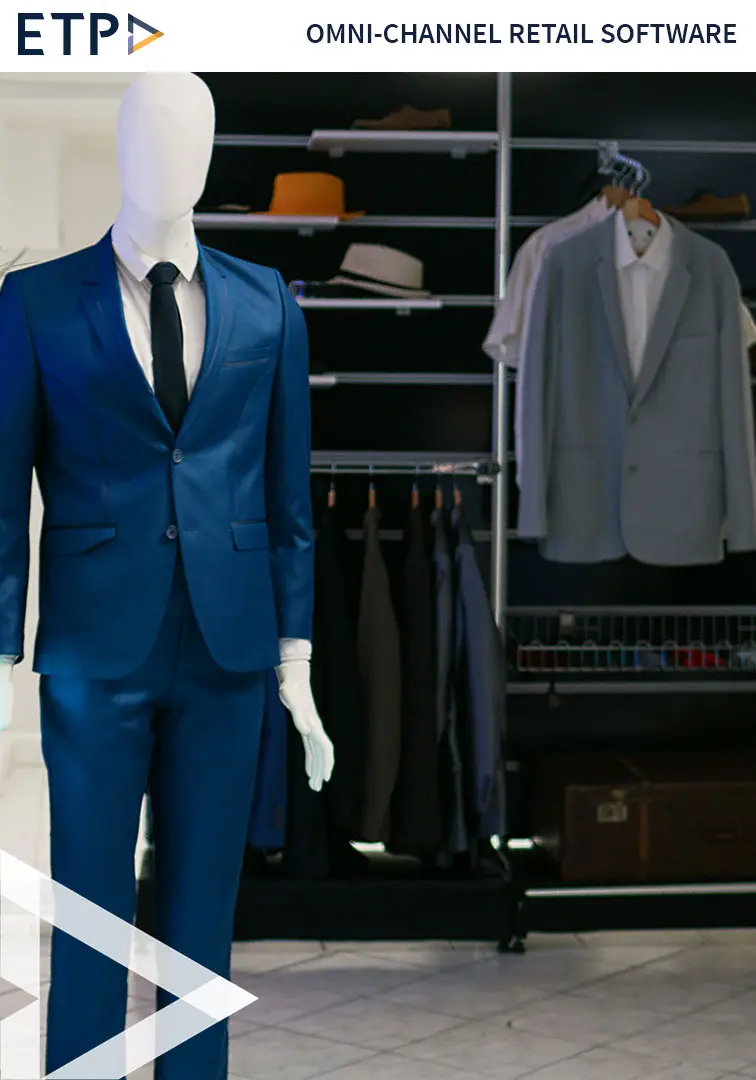
Leverage the Power of Omni Channel Retail Software: Strategies for Seamless Customer Experiences
- Partnership
Country * Aruba Afghanistan Angola Anguilla Åland Islands Albania Andorra United Arab Emirates Argentina Armenia American Samoa Antarctica French Southern Territories Antigua and Barbuda Australia Austria Azerbaijan Burundi Belgium Benin Bonaire, Sint Eustatius and Saba Burkina Faso Bangladesh Bulgaria Bahrain Bahamas Bosnia and Herzegovina Saint Barthélemy Belarus Belize Bermuda Bolivia, Plurinational State of Brazil Barbados Brunei Darussalam Bhutan Bouvet Island Botswana Central African Republic Canada Cocos (Keeling) Islands Switzerland Chile China Côte d'Ivoire Cameroon Congo, the Democratic Republic of the Congo Cook Islands Colombia Comoros Cape Verde Costa Rica Cuba Curaçao Christmas Island Cayman Islands Cyprus Czech Republic Germany Djibouti Dominica Denmark Dominican Republic Algeria Ecuador Egypt Eritrea Western Sahara Spain Estonia Ethiopia Finland Fiji Falkland Islands (Malvinas) France Faroe Islands Micronesia, Federated States of Gabon United Kingdom Georgia Guernsey Ghana Gibraltar Guinea Guadeloupe Gambia Guinea-Bissau Equatorial Guinea Greece Grenada Greenland Guatemala French Guiana Guam Guyana Hong Kong Heard Island and McDonald Islands Honduras Croatia Haiti Hungary Indonesia Isle of Man India British Indian Ocean Territory Ireland Iran, Islamic Republic of Iraq Iceland Israel Italy Jamaica Jersey Jordan Japan Kazakhstan Kenya Kyrgyzstan Cambodia Kiribati Saint Kitts and Nevis Korea, Republic of Kuwait Lao People's Democratic Republic Lebanon Liberia Libya Saint Lucia Liechtenstein Sri Lanka Lesotho Lithuania Luxembourg Latvia Macao Saint Martin (French part) Morocco Monaco Moldova, Republic of Madagascar Maldives Mexico Marshall Islands Macedonia, the former Yugoslav Republic of Mali Malta Myanmar Montenegro Mongolia Northern Mariana Islands Mozambique Mauritania Montserrat Martinique Mauritius Malawi Malaysia Mayotte Namibia New Caledonia Niger Norfolk Island Nigeria Nicaragua Niue Netherlands Norway Nepal Nauru New Zealand Oman Pakistan Panama Pitcairn Peru Philippines Palau Papua New Guinea Poland Puerto Rico Korea, Democratic People's Republic of Portugal Paraguay Palestine, State of French Polynesia Qatar Réunion Romania Russian Federation Rwanda Saudi Arabia Sudan Senegal Singapore South Georgia and the South Sandwich Islands Saint Helena, Ascension and Tristan da Cunha Svalbard and Jan Mayen Solomon Islands Sierra Leone El Salvador San Marino Somalia Saint Pierre and Miquelon Serbia South Sudan Sao Tome and Principe Suriname Slovakia Slovenia Sweden Swaziland Sint Maarten (Dutch part) Seychelles Syrian Arab Republic Turks and Caicos Islands Chad Togo Thailand Tajikistan Tokelau Turkmenistan Timor-Leste Tonga Trinidad and Tobago Tunisia Turkey Tuvalu Taiwan, Province of China Tanzania, United Republic of Uganda Ukraine United States Minor Outlying Islands Uruguay United States Uzbekistan Holy See (Vatican City State) Saint Vincent and the Grenadines Venezuela, Bolivarian Republic of Virgin Islands, British Virgin Islands, U.S. Viet Nam Vanuatu Wallis and Futuna Samoa Yemen South Africa Zambia Zimbabwe
ETP is an Omni-channel Retail Software company serving market leaders in 24 countries across the Asia Pacific, India, and the Middle East regions. ETP’s retail and e-commerce solutions include Omni-channel orchestration, POS , Mobility, CRM, Marketing Campaigns, Promotion Management, Smart Order Management, Supply Chain Management, Product Information and Inventory Management, Marketplace Management, and Analytics. ETP has successfully executed over 500 enterprise software projects for 500+ brands. ETP’s unique value proposition is its ability to consistently deliver enterprise-grade Omni-channel solutions to its customers and build long-term strategic partnerships spanning decades.
- Copyright © ETP Group Pte Ltd. All rights reserved.

B2B Customer Experience
- Customer Experience Consulting
- Net Promoter Score® Consulting
- Net Promoter Score® Software
- Customer Feedback Consulting
- B2B Marketing
- B2B Marketing Services
- B2B Lead Generation
- B2B Content Marketing
- B2B Marketing Automation
- Case Studies
- Downloads and Tools
- Our Customers
- Our Company
The 5 Stage Retail Customer Journey
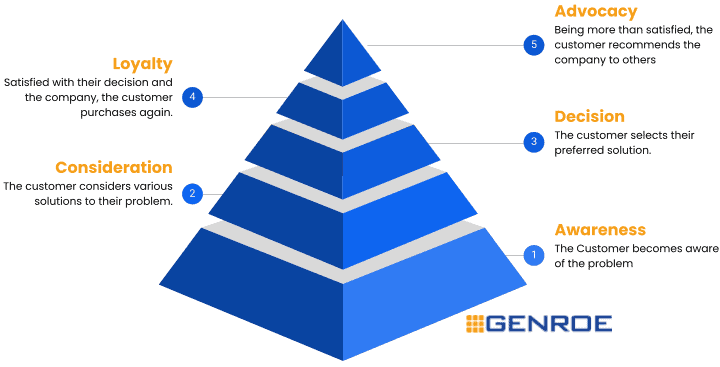
In many ways the retail customer journey is no different to the customer journeys for other industries: it seeks to identify the steps retailer’s customers make through the course of their interaction with a company.
It is true though that in the last 20 years it has become much more complex because of the impact of the internet on the way customers move along the journey and the introduction of on-line and mixed steps.
The journey has never been strictly linear, as the diagram might indicate, customers move back and forth along the journey based on their individual circumstance.
There is also no single, agreed, retail customer journey. Some versions end at the purchase, others rename, combine or separate elements, but all include the ideas outlined in this post.

Stage 1: Awareness
In this first stage of the customer journey, the customer becomes aware of their “problem”.
I’ve put the problem in inverted commas because the problem might be a desire or want for a product or service. In this case “problem” is used in a very general sense.
Customers may become aware of their problem in various ways including:
- Awakening a desire through seeing your product or service on social media.
- Walking past a display in a store
- Seeing an advertisement online or in mass media.
As you can see, while this is a retail journey, it doesn’t centre only in-store. Customers can take steps on the journey in settings other than bricks and mortar.
While the methods of generating retail customer awareness are well known, it’s difficult to measure their effectiveness.
Stage 2: Consideration
Here the customer considers various ways to solve their problem. They may look at competing retailers or manufacturers of the same product or service.
However, they may also consider alternate ways to solve the problem, in which case the consideration set may include non-competing retailers and brands.
They will undertake this consideration process in a variety of ways
- Comparing merchandise in the same physical or on-line store
- Asking friends for suggestions
- Reviewing social media
Again, it’s clear that the retail customer journey is not limited to either on-line or bricks and mortar sites.
Measurement of the Consideration stage is typically done via some type of brand awareness approach. While this doesn’t fully capture the Consideration stage it certainly helps.
Stage 3: Decision
Having examined at the various options, customers then move to make a decision that solves their “problem”.
Typically they will consider a range of objective elements such as:
- Availability: in-stock, on back order, not available
- Preferred colour, size, etc
But they will also consider a range of subjective elements such as:
- Brand persona
- Peer group norms
- Influencer recommendations
We see again that the retail customer journey is impacted far beyond the in-store experience.
Of course, the ultimate metric of the Decision stage is sales.
Stage 4: Loyalty
Where the customer is at least satisfied with their purchase, and where the “problem” is a recurring one, they enter the loyalty phase of the retail customer journey.
In the Loyalty phase the customer re-purchases the product or service into the future. Achieving good customer loyalty is one of the keys to delivering long term business growth and retaining a customer is generally accepted to be easier than gaining a new one.
There are many ways to improve customer loyalty including:
- The use of Loyalty cards and programs .
- Delivering products and services that are better than your competitors. Here “better” may be subjective or objective.
In terms of identifying when your products and service are better than your competitors, the Net Promoter Score (NPS) metric has been shown to be an effective predictor of retail customer loyalty.
Stage 5: Advocacy
The final stage of the customer journey is Advocacy. Not only is the customer loyal, they also advocate on behalf of the company: they effectively become an unpaid sales person for the retailer.
Advocacy can in itself be a powerful driver of company growth especially when combined with on-line and social media tools.
Sharing positive reviews of the company to friends and family is known to drive additional sales.
Again NPS is a common way to measure retail customer advocacy.
- Customer Journey Mapping
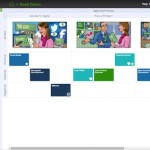
2024’s Best Customer Journey Mapping Tools

Customer Pain Points: What They Are and How to Solve Them
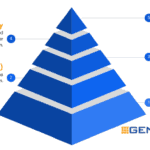
Understanding and Using the Marketing Customer Journey

Fixing Customer Pain Points Using Customer Journey Maps

How to Run a Customer Journey Mapping Workshop

The Benefits and Disadvantages of Customer Journey Mapping
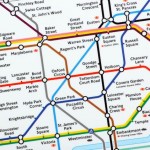
Customer Journey Vs User Journey Vs Buyer Journey: Selecting the Right Type of CX Map
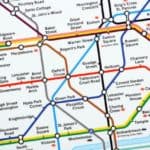
The Practical Guide to B2B Customer Journey Mapping

Buyer Personas: How to Create this Critical Business Asset
- CX Consulting
- NPS Consulting
- NPS Software
- Customer Feedback
- B2B Marketing Guide
- Customer Feedback Guides
- [email protected]
- +61 2 9191 4700
- Book a Meeting
- Level 33, 264 George St Sydney, NSW 2000
Copyright Genroe (Australia) Pty Ltd | All Rights Reserved. | Privacy Policy | Cookie Policy Net Promoter, Net Promoter Score and NPS are registered trademarks of Bain & Company, Inc., Satmetrix Systems, Inc., and Fred Reichheld.
- Skip to main content
- Skip to primary sidebar
- Skip to footer
- QuestionPro

- Solutions Industries Gaming Automotive Sports and events Education Government Travel & Hospitality Financial Services Healthcare Cannabis Technology Use Case NPS+ Communities Audience Contactless surveys Mobile LivePolls Member Experience GDPR Positive People Science 360 Feedback Surveys
- Resources Blog eBooks Survey Templates Case Studies Training Help center
In-Store Customer Journey: Definition, Importance & Stages
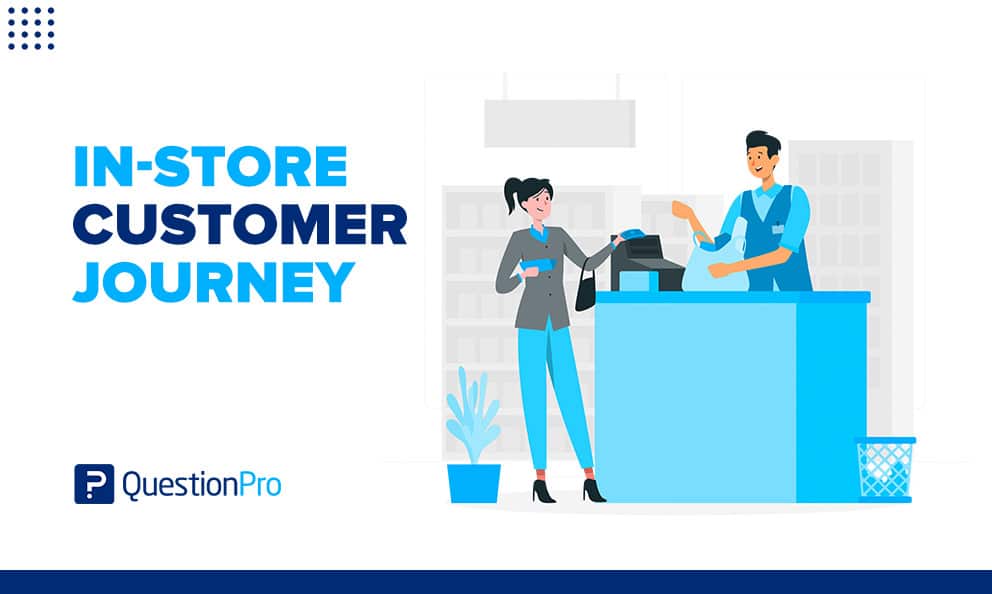
The retail sector is very broad, covering many subsectors such as fashion, home, beauty, appliances, electronics, etc. Despite the variety that exists in retail stores, the customer journey follows the same guidelines in all of them.
Businesses must understand the journey their customers take, from when they are conscious they have a need and look for options to satisfy it until they finally make the purchase.
By understanding this journey, they can better understand their target audience and offer them the shopping experience they are looking for and stand out against the growing competition.
The Customer Journey Map is the tool that allows you to draw that route. With the in-store customer journey, you will learn what the needs and preferences of customers are, but also the points of friction to improve customer service. This way you can guarantee the best customer experience.
In this article, we will cover what is an in-store customer journey, types of buyer personas, touchpoint examples, and more!
What is an in-store customer journey?
The in-store customer journey is the path a customer takes in a physical store. Mapping the customer journey interaction in a store helps track the numerous touchpoints that your customer has with your brand.
Understanding the in-store customer journey touchpoints in retail will help the business provide a better customer experience , which is directly correlated to customer retention and customer advocacy for your product or service.
Identifying touchpoints will help to identify the channels through which buyers contact the store. These channels can be physical (the store itself) or online, such as e-commerce, email, social networks, online forms, blogs, etc.
Nowadays it is essential for businesses to offer different contact channels, as customers prefer a variety of options. In addition, you should consider having an omnichannel strategy, that is, offering the same shopping experience through all channels and allowing buyers to move between one channel and another, continuing with the same process in each interaction.
Having an in-store customer journey in place is key to understanding the behavior of consumers. According to research, it is critical that 2 out of 3 investments made by retail professionals focus on improving the understanding and analysis of in-store customer journey and their behavior to improve customer experience.
If you like reading about in-store customer journeys, you might find it interesting to learn about what are online surveys .
Key Aspects of an In-Store Customer Journey
If you’d like to find out the reasons why it’s important having an in-store Customer Journey Map developed, keep on reading.
1. Define the experience to map
If you have decided to map your customer journey , you should know that you can trace the customer experience in different ways. In other words, you can draw the entire journey that customers take from when they decide to buy something until they finally do.
Or you can map a specific moment of the trip, like, for example, the moment of purchase only. This option is useful for when you already know the customer journey, but want to focus on one part of the journey to improve it.
2. Identify your ideal client
Another key step in drawing the retail store customer journey map is to identify the ideal customer or buyer persona .
You must bear in mind that, in this sector, more than others, customers can be very different. This makes it difficult to map your trip since the interaction with the business will depend on the habits of consumers.
Therefore, it is essential that you are clear about, at least, the main customer archetypes. Based on this information, you will have a better idea of how to meet their needs in each of the stages of the customer journey. These are some of the main buyer journeys that you can find in the retail store.
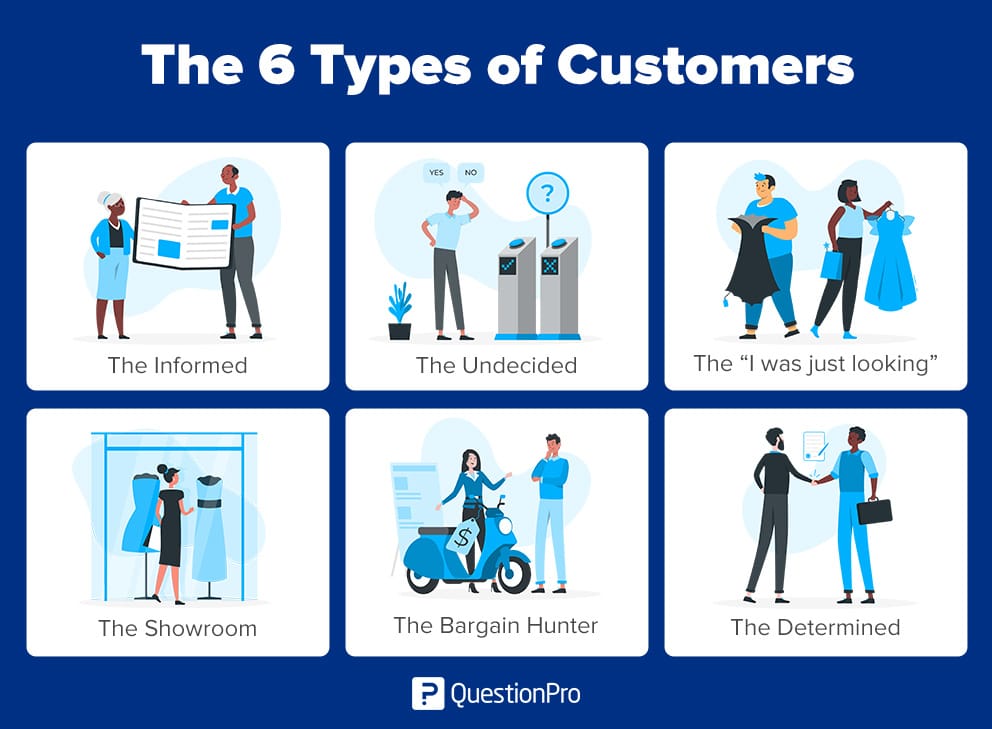
a) The informed
It is the type of client that investigates in depth before making their purchase decision. They read product descriptions, review ratings and reviews from other customers, compare prices, etc. Therefore, when they enter a store they already know what you have to offer them and they usually come with a battery of questions and doubts about the product. For these customers, it is important to have highly-trained customer service staff on all technical aspects of the product.
b) The undecided
This is the client that has detected a need, but not the best solution. They are not sure about the purchase, so he prefers to wait to make the decision. Your indecision may be caused by being overwhelmed with the number of options on the market or not knowing enough about what you want to buy. This type of client, not being an expert, needs to be accompanied in the purchase decision and patiently advised by the salespeople of the retail store.
c) The ‘I was just looking’
It is the type of customer who wanders through the store and who initially has no real intention of buying. They may have entered the business because they are killing time or because something caught their attention. Normally, it is possible that you have not even identified the solution to your possible need, so a good way to find out is to gossip about what is on offer. This is a type of customer who can end up being very impulsive in making a purchase if a good salesperson knows how to create the need for them and show them alternative solutions.
d) The showroom
It is the buyer who goes to the store to investigate or try a product, but who makes his purchase online. Many customers still need to physically see the product, experience it, and confirm that it is indeed what they need. The fact that you complete the purchase through the internet can be for many reasons, comfort, price, you were thinking about it and you don’t want to go back to the store a second time. The important thing, whatever the reason, is that the brand ensures that the shopping experience is truly omnichannel and the customer does not have the feeling of impulsive buying in two different stores.
e) The bargain hunter
It is the customer whose main motivation is price. They look for the lowest and can go from store to store until they get it. In this type of buyer, loyalty is very complicated because decision-making only depends on the price factor. It is not the ideal customer because it will be difficult to convert it into a regular customer with a certain recurrence of purchase.
They are going to be a very sensitive customer to offers and promotions, and we will have them whenever we lower the price. But the real challenge with these users is to be able to get them to perceive a differentiation in the brand with respect to the competition, so that price is not the only deciding factor. But do not despair, the real percentage of this type of client is very low compared to the rest of the buyers’ persona.
f) The determined
They are very direct customers because they already know what they want. Your goal is to enter the store, find the product, buy it and leave as soon as possible. They have clearly identified their need and the product that solves them.
Normally, they are repeat customers who already know the brand and have bought those products before. The mission with these clients is to achieve recurrence and improve the average purchase receipt.
If you like reading about an in-store customer journey, you might find it interesting to learn about how to create a customer journey canvas
LEARN ABOUT: Customer Experience vs. Customer Service
The 5 phases of the in-store customer journey
Throughout the in-store customer journey, customers go through different phases. These are well-differentiated, but in the case of the retail store, since there may be different types of consumers, each phase can vary considerably.
These are the phases of an in-store customer journey:
Phase #1: Before the purchase
This is the stage in which the buyer realizes that he has a need and that he wants to satisfy it. It is the moment when people decide to do research on retail stores that could meet their needs.
To this end, customers do searches on Google, on social networks, visit the physical store if there is one or even ask family and friends to recommend a brand.
- Consideration
The consideration stage begins when potential customers have already found your store after their research. They have already found out about your location, and what you offer and they think your business could meet their needs.
However, they have also looked at other options, so they are evaluating which one suits you best.
Phase #2: Purchase
After considering their options, the customer finally decides on your business and makes the purchase. At this time it is key that stores offer all the facilities so that the process is carried out in the most efficient way possible, whether in a physical store or online.
Phase #3: After the purchase
After the purchase, the customer journey does not end. The third phase begins, which is the post-purchase, in which the objective is customer retention. Right now, stores need to apply loyalty strategies to keep customers coming back for more.
Recommendation
It is the last stage of the customer journey and depends on what the business has done in the previous stages. If throughout the customer journey your business offers a good experience to customers, it is very likely that they will recommend the store to their acquaintances.
If you like reading about what in-store customer journey, you might find it interesting learning about customer journey vs customer experience: the difference .
Identify the touchpoints of an in-store customer journey
Shopper interaction with the store happens multiple times throughout the customer journey. These are the so-called touchpoints and it is essential to identify them in order to create different strategies to facilitate interactions.
- Search for information on retail stores: know the existence of the store and investigate it and what it offers.
- Feedback research from other buyers: Search for comments and reviews about the buying experience of other customers.
- Search for promotions: investigate the availability of discounts or special offers on different types of products.
Acquisition
- Product request: visit or contact the store to make the purchase.
- Delivery of personal data: request for personal data by the store.
- Payment: payment process for the purchased product.
- Customer recommendations: take criticism, be it positive or negative, about the retail store.
- Loyalty program: includes a points program, offers or discounts for a future purchase.
- Complaint: the client makes a direct complaint about a negative experience.
- Internet review: the buyer leaves a review or comment of the business, which can be positive or negative.
Learn what are in-store surveys and how to use them.
LEARN ABOUT: Consumer Decision Journey
How to make the best out of in-store customer journeys
The customer journey map is a fundamental tool to get to know your customers and thus improve their experience throughout their journey. With QuestionPro CX you can deploy offline/online customer satisfaction surveys strategically at every touchpoint in your customer journey with questions having NPS incorporated. You can also make better decisions with actionable insights provided by smart dashboards, reports, and our exclusive NPS+ question.
Work hand in hand with CX professionals and ensure the best customer experience. Although competition in the retail sector is increasing, if you apply tools such as the ones QuestionPro CX offers you can boost your customer loyalty and retention.
At QuestionPro CX we offer you the best tools to monitor the customer journey in your organization. Contact us! We would love to team up with you to help you achieve better customer experiences!
LEARN MORE FREE TRIAL
MORE LIKE THIS

15 Best Customer Experience Software of 2024
May 2, 2024

Journey Orchestration Platforms: Top 11 Platforms in 2024

Top 12 Employee Pulse Survey Tools Unlocking Insights in 2024
May 1, 2024

Taking Action in CX – Tuesday CX Thoughts
Apr 30, 2024
Other categories
- Academic Research
- Artificial Intelligence
- Assessments
- Brand Awareness
- Case Studies
- Communities
- Consumer Insights
- Customer effort score
- Customer Engagement
- Customer Experience
- Customer Loyalty
- Customer Research
- Customer Satisfaction
- Employee Benefits
- Employee Engagement
- Employee Retention
- Friday Five
- General Data Protection Regulation
- Insights Hub
- Life@QuestionPro
- Market Research
- Mobile diaries
- Mobile Surveys
- New Features
- Online Communities
- Question Types
- Questionnaire
- QuestionPro Products
- Release Notes
- Research Tools and Apps
- Revenue at Risk
- Survey Templates
- Training Tips
- Uncategorized
- Video Learning Series
- What’s Coming Up
- Workforce Intelligence
Personalizing the customer experience: Driving differentiation in retail
Today’s retail environment is challenging from almost any perspective because of price pressure from discounters, market disruption from online players, and increased price transparency for shoppers. Traditional differentiation approaches in retail—such as a unique selection or strategic pricing and promotions—are not as effective as they once were, as competitors can easily imitate them. But differentiation is still possible through personalized approaches in which retailers create unique experiences tailored to individual customers.
Highly personalized customer experiences, when offered to millions of individual customers by using proprietary data, are difficult for competitors to imitate. When executed well, such experiences enable businesses not only to differentiate themselves but also to gain a sustainable competitive advantage. Moreover, our research has shown that personalized experiences drive up both customer loyalty and the top line.
Meeting customers’ expectations for a personalized experience
Thanks to online pioneers, such as Amazon, customers have grown to expect and desire personalized experiences: a survey of 1,000 US adults by Epsilon and GBH Insights found that the vast majority of respondents (80 percent) want personalization from retailers. 1 “New Epsilon research indicates 80% of consumers are more likely to make a purchase when brands offer personalized experiences,” Epsilon, January 9, 2018, us.epsilon.com. Personalization can even be called a “hygiene factor”: customers take it for granted, but if a retailer gets it wrong, customers may depart for a competitor.
Personalization, once limited mainly to targeted offers, now extends to the entire customer experience. This means that customers want personalization throughout their interactions with a retailer—with multiple, personalized touchpoints that enable them to allocate their time and money according to their preferences. In the best personalized experiences , retailers make the customer part of the dialogue and leverage data to create one-to-one personalization. Customers receive offers that are targeted not just at customers like them, with brands targeting at the segment level with broad-based offers, but at them as individuals , with products, offers, and communications that are uniquely relevant to them.
Understanding how personalization pays off
Given customers’ expectations, retailers must respond to the demand for personalized experiences not only to differentiate themselves but just to survive. When done right, though, personalization allows retailers to do more than merely survive: it enables them to thrive. Personalization at scale (in which companies have personal interactions with all or a large segment of their customers) often delivers a 1 to 2 percent lift in total sales for grocery companies and an even higher lift for other retailers, typically by driving up loyalty and share-of-wallet among already-loyal customers (for whom data are more abundant and response rates are higher). These programs can also reduce marketing and sales costs by around 10 to 20 percent.
Not only that, successful personalization programs yield more engaged customers and drive up the top line. In general, a positive customer experience is hugely meaningful to a retailer’s success: it yields 20 percent higher customer-satisfaction rates, a 10 to 15 percent boost in sales-conversion rates, and an increase in employee engagement of 20 to 30 percent. Customer-experience leaders in the retail space (retailers with consistently high customer-satisfaction scores) have provided their shareholders with returns that are three times higher than the returns generated by retailers with low customer-satisfaction scores.
To maximize the results of a personalization program, we recommend focusing initially on the most loyal customers, as programs targeting regular shoppers yield a return on investment three times higher than that of mass promotions. Moreover, building data on the most loyal customers sets off a virtuous cycle by generating ever-more-relevant data and higher response rates that further boost data quality.
Would you like to learn more about our Retail Practice ?
Learning from success stories.
Retailers across many different categories have managed to implement personalization at scale effectively and have significant success to show for the effort. Of course, Amazon has been a pioneer in this field, but other companies—including grocery companies, which make up for what they lack in e-commerce data with loyalty data from their physical stores—have moved into the top tier in recent years with successful personalization programs of their own.
Personalization pioneer: Amazon
As the ruler of large, pure-play, online retailers, Amazon has used sophisticated analytics to shape its personalization efforts. Over time, Amazon has expanded its personalization program to show customers products that are often purchased with the item they are viewing, display items that can be bundled with products in a customer’s cart, and recommend additional products in the e-mails it sends to confirm transactions.
Amazon continues to raise the personalization bar with ever-more-granular, -innovative offerings to individual customers. For example, Amazon Prime Wardrobe has recently launched a personal shopping service exclusively for Prime members. Customers complete a survey about their styles and fit preferences, and a team of stylists provides personalized recommendations from more than half a million items across brands. Amazon will probably continue to lead innovation in personalization, but other, smaller retailers—with far less sophisticated systems—are setting new standards, too.
Dynamic personalization: European grocer
A large European grocery company has successfully moved from one-size-fits-all marketing to personalized experiences. This shift began with research based on the retailer’s macrosegmentation; the retailer was then able to drill down a level further to create smaller segments based on location, time of day, and other specifics. From there, the grocer built a new transaction engine so it could institute business rules. For example, the engine does not offer discounts to regular shoppers who buy coffee or lunch at the store every day. Instead, it routes discounts toward other segments and users of the grocer’s smartphone app, who receive offers as they pass by the store.
The rich data from this grocer’s transaction engine, personalization engine, mobile app, and other tools have allowed the company to track sales across its entire network of locations—enabling the grocer to optimize for weather, day of the week, time of day, and similar data points that greatly enhance the effectiveness of promotions.
Omnichannel experience: Sephora
Sephora, an international beauty-products retailer, offers personalized experiences that are truly omnichannel in their presentation to consumers. The company’s digital channels—particularly its mobile app—encourage customers to book in-store makeovers and fashion consultations. The app’s “in-store companion” feature enables users to find a store, check to see if an item is in stock, and book a reservation. When customers choose to have their makeup done in stores, they receive a log-in for the app so that the makeup artist can input each product she or he used into the customer’s personal profile. The app also allows customers to virtually try on products and to receive recommendations based on their personal beauty traits. When customers visit a Sephora store, they can use the app to find the products they have virtually sampled.
All of Sephora’s customer communications—no matter the platform—display the customer’s loyalty points. Sales associates can see these point totals, too, and can access a customer’s profile in store. The profile includes data on the customer’s in-store purchases, online browsing and purchasing patterns, and interactions with in-store salespeople.
Sephora’s program is notable for another reason, too: it clearly demonstrates the effectiveness of focusing on the most loyal customers. The company’s tiered loyalty program, Beauty Insider, offers its highest-level members early access to new products, invitations to exclusive events, free custom beauty services, and more. All members receive customized recommendations based on profiles they fill out online. Their profile details—such as first name, buying habits, and quiz responses—are deployed across channels. Store associates can access a customer’s profile in the store and track items that were sampled, making it easy for customers to find and buy those items on the website or app. Every communication from the brand, on every platform, displays the customer’s loyalty points, and offers are synchronized across platforms.
The results of Sephora’s personalization efforts have been striking. The loyalty program now has around 25 million members. In 2018, members accounted for 80 percent of Sephora’s total transactions. 2 Pamela N. Danziger, “How to make a great loyalty program even better? Sephora has the answer,” Forbes , January 23, 2020, forbes.com; James Stewart, “Sephora gets 80% of its sales from this,” Ragtrader , November 6, 2018, ragtrader.com.au. And for the third year in a row, with a score of 79 out of a possible 100, Sephora has claimed the top slot in Sailthru’s Retail Personalization Index. 3 “The 3rd annual Retail Personalization Index,” Sailthru, September 17, 2019, sailthru.com.
In-store personalization: Nike
Not to be outdone in the personalization game is Nike, one of the largest athletic-footwear and athleisure companies in the world. Nike has taken personalization all the way to the individual product by allowing customers to configure their own clothes and shoes. The company recently launched a 3-D sneaker-customization platform that allows shoppers to generate real-time, shareable snapshots of finished footwear.
Personalization extends to Nike’s physical locations, too. Nike’s flagship store in New York City offers a compelling omnichannel shopping experience driven by membership in NikePlus, the company’s personalized loyalty program. Members receive personalized, exclusive benefits, such as access to Nike Speed Shop, which offers a data-driven, locally tailored assortment of “NYC favorites.” Members can also reserve items to be stored in pickup lockers and retrieve them by scanning their NikePlus member pass. With Nike Shop the Look, members can use QR-code-scanning to determine the availability of their preferred sizes and colors and to request delivery to their selected pickup location or dressing room. Using Instant Checkout, members can skip the cash-register line and check out directly from their own stored-payment device. Other benefits include access to Nike Expert Studio, where members can book personal, one-on-one appointments with Nike experts, and the opportunity to book appointments with Nike by You, where members can view a selection of silhouettes that are uniquely fitted to their specifications.
The necessary changes require a significant shift in the mindsets of employees so that they become comfortable with the experiments personalization requires.
Identifying common challenges for retailers
Given the success stories, it is little surprise that, in a Periscope by McKinsey survey of retailers attending World Retail Congress 2017, 95 percent of retail CEOs say personalizing the customer experience is a strategic priority for their companies. But that same survey showed that only 23 percent of consumers believe that retailers are doing a good job in their personalization efforts. What is behind this disparity?
First of all, most retailers are still in the early stages of their personalization efforts. Our research indicates that only 15 percent of retailers have fully implemented personalization strategies. More than 80 percent are still defining a personalization strategy or have begun pilot initiatives. The remaining retailers have decided to deprioritize personalization for now, for various reasons.
Retailers seem to be facing four main tactical challenges in getting personalization off the ground:
- Data management. More than two-thirds of survey respondents (67 percent) indicate that their greatest personalization challenge is the gathering, integration, and synthesis of customer data.
- Data analytics. Acquiring and maintaining in-house expertise in analytics and data science are proving to be major concerns for 48 percent of surveyed retailers.
- Alignment of retail organizations across functions. For many retailers, siloed processes and organizational models prevent the efficient and prompt sharing of customer data and promotion decisions (for example, difficulty in aligning the marketing and merchandizing teams). Of the survey group, 43 percent say these silos “make life difficult,” and 25 percent report that such silos make it difficult to get vendor funding—as well as buy-in—from suppliers for personalized offerings (especially in the grocery category). In many cases, these sorts of changes require a significant shift in the mindsets of employees so that they become comfortable with the test-and-learn and fast-fail experiments that personalization requires.
- Tools and technology enablement. Of the survey participants, 67 percent admit that they did not have the correct tools in place to execute personalization at scale. An additional 41 percent say finding the right solution partner was a struggle.
These challenges are further complicated by the fact that many retailers still operate under a hybrid, “bricks and clicks” strategy, making it even more difficult to implement the right levels of personalization in stores and online. Retailers with an omnichannel setup, however, have their own challenges, particularly in structuring offers and executing across communication touchpoints.
Overcoming the obstacles
All is not lost, however. As our previous case examples show, retailers across the spectrum have managed to create truly personalized experiences for both the online world and brick-and-mortar channels. The results for both the affected customers and the financial results are impressive. So how do these retailers do this?
There is no single winning recipe, as the breadth of our case examples shows. In our experience, though, an effective personalization operating model has four prongs: a data foundation, decisioning, design, and distribution (exhibit). Within this model are eight core elements.
First, all of these retailers have started small. They begin by testing and learning while building the necessary capabilities and multidimensional intelligence on customers over time. Data management is crucial here: getting the right data is much more important than gathering every last scrap of data. The customer database needs to be multidimensional, but it does not have to provide a 360-degree view of customers. Successful retailers start by gathering the most important data before scaling up to a broader understanding of each individual customer.
A detailed customer segmentation and analysis is the next common element. With the right data management and analytics in place, retailers can identify customers’ value triggers and then score and rank customers to facilitate effective targeting and personalization.
Developing a playbook of responses to certain triggers—such as abandoning a shopping cart and browsing of items that belong to a larger collection—is the third element. The goal here is to build a library of offers, with a few hundred as a good starting point. Some companies eventually build a large library of content that they can put together into a personalized magazine for customers. The right mix of triggers results in open and click-through rates that outperform those of traditional mass marketing.
The fourth element is a robust decisioning engine (campaign coordination) that plans experiences across multiple channels and reduces the risk of sending conflicting messages. It also allows retailers to drive the value created by each touchpoint and to maximize that value across the multichannel lineup.
An agile cross-functional team is the fifth element. A team room should be staffed by a cross-functional team—the engineers, merchandising professionals, and marketing experts should all be in one room. The team’s work should include weekly deployments implemented with a test-and-learn spirit more commonly found in the internet software betas of Google and other web giants. The goal of this cross-functional room is to break down organizational silos and to have mixed teams working together to increase pace and quality.
The sixth element of a successful personalization effort is securing the right talents, capabilities, and culture to staff the team. The leadership needs to set the right example at the outset, but from there, the program will touch everyone from the HR team to the marketing and merchandising staffs. The right mix of data scientists and marketing-technology experts is also necessary.

The end of shopping’s boundaries: Omnichannel personalization
The right technology enablement can be complex to implement, but it forms the core—and the seventh element—of a successful personalization effort. Getting the various systems to work together and pull in the same direction can form the commercial heart of an organization. Most retailers are not maximizing the value that their existing technology platforms can offer, so unifying the systems will squeeze more value from them along the way. Building a more flexible platform on top of legacy systems is often beneficial, too.
Finally, retailers should undertake this effort with a test-and-learn approach . There is no need to build a vast, multivariable database as the first step. As the exhibit notes, do not wait for perfection. Instead, start small. Pick a straightforward experience that will generate a positive impact and start with that. Test the efficacy of that idea, generate useful metrics, and then expand to a second idea. Repeat. As the resulting impact is quantified, and the insights generated by experiments are funneled back to the team, the loop will be closed on the analytics powering each deployment.
In some retail sectors (the grocery sector, for example), collaboration with suppliers is important. The goal here is to build a mutually beneficial partnership with the supplier. To do so, shift funding from mass promotions to personalized experiences and give vendors full transparency into how their products perform. Additionally, provide each vendor with a point person who manages its relationship with the retail network. This person will quickly become a strategic partner who helps better align the retailer and supplier.
All eight elements humming in unison will form an effective personalized-experience engine that differentiates the retailer, increases share of wallet among the most loyal customers, and ultimately boosts the retailer’s top and bottom lines.
Getting started
Given the potential impact of personalization, it makes sense that retailers would be eager to begin their personalization efforts. But how can they do that thoughtfully?
The first step is to define a short list of high-impact use cases that are relevant to the consumer but not too complex to execute against. A skilled cross-functional team can then be assembled to construct an integrated database for those use cases. The team should make sure that the data are both highly available and targeted while also considering the needs of future programs (including high-impact use cases). This database does not need to be perfect. Rather, it should be built through iteration, testing, and learning.
To begin building a personalization program—and to fuel its effective execution—retailers should create a cross-functional team to test and learn from experiments. Analytics and technology professionals will be critical to the program, especially when scaling it up. Finding the right external partner to help develop the personalization program is important, too, and will help accelerate the retailer’s progress toward results: a more personalized experience, greater customer loyalty, marked differentiation, increased wallet share, and substantially better top and bottom lines.
Erik Lindecrantz is a partner in McKinsey’s Tokyo office, Madeleine Tjon Pian Gi is a partner in the Amsterdam office, and Stefano Zerbi is a senior partner in the Milan office.
Explore a career with us
Related articles.

Consumer-data privacy and personalization at scale: How leading retailers and consumer brands can strategize for both

The future of personalization—and how to get ready for it
- Case studies
- Expert advice
Customer behavior in retail stores: Why businesses should care
Retail is a business where every product and display has a story driven by customer choices, preferences, and decisions. Understanding customer behavior in retail is not just insightful — it's crucial. It's about deciphering a complex language that transforms a routine shopping trip into an engaging journey for buyers and sellers.
As customers navigate the store, their interactions — a lingering glance, a swift selection, or a hesitant step back — tell a rich tale. These actions raise questions: Why do certain items never last on the shelves while others barely get noticed? What draws a shopper to one product display over another? And what makes buyers go back to a particular store, forgetting another?
In this article, we'll explore customer behavior in retail stores by shedding light on the secrets behind the shopping journey, revealing how the proper understanding of customer behavior can turn the ordinary into the extraordinary within the lively aisles of retail.
- 1 Customer buying behavior in retailing: an up-close look
- 2 Customer’s buying behavior patterns
- 3 Customer’s buying stages and related behaviors
- 4 How to gather data on consumer behavior in retail?
- 5 Using consumer behavior insights to drive business
- 6 Wrapping up
Customer buying behavior in retailing: an up-close look
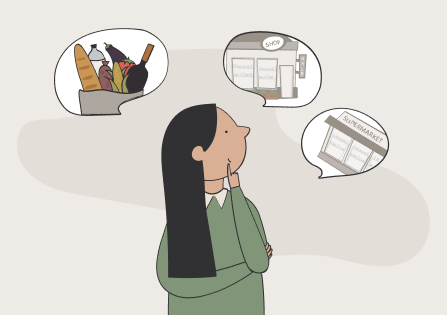
Customer buying behavior in retail refers to the patterns of how individuals or groups select, purchase, use, or dispose of products, services, experiences, or ideas to satisfy their needs and desires within a retail environment. Many factors, including personal preferences , cultural norms, social influences, and psychological drivers, influence this intricate dance of decision-making.
At its core, consumer behavior in retail seeks to understand the "why" behind a shopper's actions. For example, why does one shopper gravitate towards organic produce while another consistently seeks the cheapest options? These choices are not random; they are deeply rooted in the shopper's values, financial situation, lifestyle, and even their perception of brands and trends.
Let's consider a typical scenario: A family enters a retail store with a shopping list for their weekly groceries. The parents head straight to the fresh produce section, prioritizing health and nutrition. At the same time, their children are more drawn to the cereal aisle, influenced by colorful packaging and favorite cartoon characters. Here, consumer behavior is shaped by a blend of individual preferences (health consciousness, taste, and budget) and external influences (advertising, peer pressure, and in-store promotions).
By understanding customer behaviors, retailers can strategically design their stores to enhance the customer experience and influence purchasing decisions. Retailers can nudge customers towards certain products by placing popular items at eye level, creating enticing product displays, or offering samples and promotions. The layout of the store, the ambiance, and even the background music are all carefully curated elements that can subtly affect a shopper's mood and willingness to buy. Incorporating this understanding into sales strategies, marketing initiatives, and advertising campaigns allows for a more targeted approach that can significantly increase effectiveness.
This profound insight into customer behavior can inform the development of personalized marketing messages, tailored advertising content, and strategic product placements, all of which can lead to increased customer engagement, higher sales, and enhanced brand loyalty. By aligning sales strategies, marketing, and advertising with customer behavior insights, retailers can create a cohesive and compelling shopping experience that resonates with their target audience, driving immediate purchases and long-term customer relationships.
In essence, consumer behavior in retail is a multifaceted phenomenon that encompasses the entire shopping journey — from the moment a need arises, through the selection and purchase of products, to post-purchase evaluation and potential return visits. Retailers who master the art of interpreting and responding to consumer behavior can significantly enhance customer satisfaction, loyalty, and, ultimately, their bottom line.
Customer’s buying behavior patterns

Understanding customer buying behavior patterns involves recognizing the distinct archetypes or personas that shoppers typically embody. These personas help businesses tailor their marketing strategies and product offerings to meet the needs and desires of their target audience. Here are a few examples of these archetypes :
- Value seeker. This customer is always on the lookout for the best deal. They spend time comparing prices and looking for discounts and are more likely to be influenced by promotions and sales. For instance, a Value Seeker might scour different websites for the lowest price on a new smartphone, taking advantage of seasonal sales or coupon codes to get the best possible deal.
- Loyalist. Loyal customers prefer certain brands or stores due to positive experiences, product quality, and emotional connection. They often make repeat purchases and are less price-sensitive. For example, a Loyalist might consistently buy their coffee from the same brand, regardless of price fluctuations, because they trust the taste and quality.
- Impulse buyer. This type of customer makes spontaneous purchases with little prior planning or research. Their buying decisions are often driven by emotions or the immediate appeal of a product. An Impulse Buyer might spontaneously add trendy clothing to their cart while browsing online, attracted by the item's visual appeal and a desire for instant gratification.
- Researcher. Researchers take a deliberate approach to shopping, spending considerable time gathering information, reading reviews, and comparing features before making a purchase. They value informed decision-making and are less likely to be influenced by aesthetics. A Researcher, for instance, might spend weeks comparing different models of laptops, reading technical reviews, and watching comparison videos before choosing the one that best meets their specific needs.
- Ethical shopper. This persona prioritizes products and brands that align with their personal values, such as sustainability, fair trade, and ethical manufacturing practices. They are willing to pay a premium for environmentally friendly or socially responsible products. An Ethical Shopper might choose a more expensive coffee brand offering fair trade and organic beans over a cheaper option.
In practice, companies like Zara have mastered the art of responding to buying behavior patterns with fast fashion cycles, quickly moving from design to retail floors to capitalize on current trends and consumer desires. Meanwhile, platforms like Netflix use data analytics to understand viewer preferences and tailor content and recommendations, keeping subscribers engaged and reducing churn .
Customer’s buying stages and related behaviors
The customer buying process is also a journey that consists of multiple stages, each characterized by specific behaviors and considerations. Here's an overview of the typical stages in the customer buying process and the related stuff:
- Need recognition. This initial stage occurs when customers realize they have a specific need or problem. For instance, an avid runner may notice their running shoes are worn out, triggering the need for a new pair. Retailers tend to stimulate this recognition through advertising, showcasing the latest in athletic footwear technology, or offering promotions on sports gear.
- Information search. Once the need is acknowledged, the consumer seeks information on how to fulfill it. It often involves online research, reading reviews, or asking friends for recommendations. A real-case example is the rise of influencer marketing, where consumers turn to trusted figures on social media to gather opinions and insights on products.
- Evaluation of alternatives. Armed with information, the shopper evaluates different products or brands. Criteria such as price, quality, and brand reputation play significant roles here. For example, a customer deciding between Nike and Adidas running shoes might compare their features, prices, and customer reviews to determine which ones offer the best value for their needs.
- Purchase decision. After considering the options, the customer makes their purchase decision. However, factors like a salesperson's recommendation or a last-minute discount can still influence this stage. Online retailers like Amazon excel by offering seamless checkout processes, customer reviews, and personalized recommendations that help nudge consumers towards a decision.
- Post-purchase behavior. Finally, as customers use their purchase, they reflect on their experience. If the product meets or surpasses their expectations, they remain satisfied and will likely buy again and recommend the brand to their friends and family. On the other hand, an unhappy customer will leave a negative review and is unlikely to return. An illustrative case is Apple's approach to customer service and its ecosystem, which aims to ensure high satisfaction levels, fostering brand loyalty and advocacy.
Delving deeper into the stages allows retailers to create targeted strategies that engage consumers at each stage of their buying journey . For example, the content department can provide valuable information during the search phase, while loyalty programs and exceptional after-sales service address post-purchase satisfaction.
How to gather data on consumer behavior in retail?

Gathering data on customer behavior in retail is an art and science. It can be a mix of traditional observation with cutting-edge technology to uncover the secrets behind shopping habits. This process helps retailers and marketers craft strategies that resonate deeply with their target audience. Let's explore the methods that light the way to understanding the consumer psyche.
- Surveys and questionnaires. This classic method involves asking consumers directly about their preferences, purchasing habits, and satisfaction levels. For instance, a fashion retailer might send out a survey asking customers about their favorite styles, shopping frequency, and feedback on recent purchases. Surveys can be conducted online, in-store, or via email, providing valuable insights straight from the source.
- Observational research. Sometimes, watching consumer behavior in action offers the most precise insights. Retailers may use in-store cameras or track movement patterns to see how shoppers navigate the space, which displays attract the most attention, or how long they engage with certain products. A real-world application of this is the heatmap technology used by stores to identify hotspots and dead zones, allowing for strategic product placement and store layout optimization.
- Sales data analysis. Delving into sales records can reveal patterns in purchasing behavior, product popularity, and seasonal trends. By analyzing this data, retailers can identify which products are bestsellers, which need a promotional boost, and how sales correlate with marketing campaigns. For example, a grocery store chain analyzing its sales data might notice an uptick in baking supplies sales around the holiday season, prompting them to stock up in anticipation each year.
- Social media listening. Consumers often share their opinions and experiences online in today's digital world. Tools that monitor social media platforms like Hootsuite or Brandwatch can capture mentions of brands, products, and overall sentiment, offering real-time insights into consumer attitudes. A notable case is Starbucks' use of social listening to gauge reactions to their holiday cup designs, helping them tweak their approach to seasonal branding.
- Loyalty programs. By offering rewards for repeat purchases, loyalty programs encourage customer retention and collect detailed data on individual shopping habits. This information can be used to personalize marketing efforts, recommend products, and create targeted promotions. Sephora's Beauty Insider program is a prime example, using purchase history to offer tailored beauty advice and product suggestions.
- Online behavior tracking. For e-commerce, tracking tools can analyze website visits, clicks, cart additions, and abandonment to understand how consumers interact with online platforms. This method helps retailers optimize their websites for better user experiences, reduce cart abandonment rates, and increase conversions. Amazon excels in this area, constantly refining its user interface based on extensive analysis of online shopping behaviors.
- Customer feedback. Direct feedback, whether through reviews, comment cards, or customer service interactions, provides unfiltered insights into consumer satisfaction and areas for improvement. Negative feedback can be as valuable as positive, highlighting issues that may not be apparent through other data-gathering methods. Apple, known for its dedication to customer satisfaction, actively uses feedback to enhance product features and service quality.
Using consumer behavior insights to drive business

Unlocking the treasure trove of consumer behavior insights is akin to finding a map that leads directly to your customers' hearts and minds. When businesses harness this knowledge effectively, they can steer their strategies towards more engaging, satisfying, and ultimately profitable interactions. Here's how to set sail on this voyage of discovery and application.
- Personalized marketing. Tailoring your marketing messages to meet your audience's specific needs and preferences can significantly boost engagement and conversion rates. For instance, Netflix uses viewing habits to recommend shows and movies, creating a highly personalized experience that keeps subscribers coming back for more. This level of customization makes customers feel understood and valued, fostering loyalty and increasing retention.
- Product development and innovation. Consumer behavior insights can guide the development of new products or the improvement of existing ones. Apple's continuous innovation in product design and functionality is often driven by deep insights into consumer needs and technology trends. By staying ahead of these curves, Apple ensures its products remain highly desirable and relevant.
- Enhancing customer experience. Understanding the nuances of how customers interact with your brand across different touchpoints enables businesses to refine the customer journey, making it as smooth and enjoyable as possible. Zappos, known for its exceptional customer service, leverages consumer feedback and behavior analysis to continuously enhance its service model, from free shipping and returns to 24/7 customer support, ensuring a shopping experience that exceeds expectations.
- Strategic store layout and merchandising. Retail giants like IKEA use consumer behavior insights to design store layouts that optimize the shopping experience. By understanding how customers navigate their stores and interact with products, IKEA creates pathways that encourage exploration and engagement, strategically placing items to maximize visibility and attractiveness.
- Effective pricing strategies. Insights into consumer price sensitivity and perceived value can help businesses set prices that customers are willing to pay while ensuring profitability. Dynamic pricing strategies, used by companies like Amazon, adjust prices in real-time based on demand, competition, and customer behavior in retail, ensuring they remain competitive and maximize sales.
- Targeted advertising. Data on consumer preferences and behaviors enables businesses to create more effective advertising campaigns by targeting specific segments with messages that resonate. Coca-Cola, for instance, crafts its advertising campaigns around themes of happiness and togetherness, which appeal to its broad consumer base's emotions, leading to more impactful and memorable ads.
- Improving online presence. Online shopping behaviors offer insights into how businesses can optimize their websites and digital platforms for better user experiences. By analyzing click-through rates, navigation patterns, and conversion funnels, companies can identify friction points and opportunities for improvement. Google's constant updates to its search algorithm reflect a deep understanding of user search behavior, aiming to provide the most relevant and valuable results quickly.
- Developing loyalty programs. Insights into what customers value most in their shopping experience can help businesses design loyalty programs that reward and encourage repeat business. Starbucks' Rewards program, for example, uses purchase data to offer personalized perks, such as free birthday drinks and customized offers, increasing customer engagement and loyalty.
By applying consumer behavior insights across these areas, businesses can create a virtuous cycle of continuous improvement and growth. The key lies in listening closely to your customers, interpreting the data with a keen eye, and being ready to adapt and innovate.
Wrapping up
As we conclude our exploration of consumer behavior in retail, it's clear that understanding customer decisions is crucial for retail success. Insights into consumer behavior guide businesses toward not only meeting but anticipating customer needs, thereby enhancing every aspect of the shopping experience.
Companies like Netflix, Apple, and IKEA have shown how deeply understanding consumer preferences can transform product offerings and marketing strategies into experiences that deeply resonate with consumers. This alignment fosters loyalty and sets the stage for innovation and growth.
You can go the same way and start by mapping your consumer behavior journey in UXPressia.
Related posts
Rate this post


Advertisement
2024 Store Design & Experience Survey: The Future of the Store

Since the inception of the Store Design & Experience survey, retailers have repeatedly emphasized the importance of the in-store experience, especially its unique role in driving consumer connection and engagement. But we wanted to gauge whether this “importance” was translating into tangible action.
Through a survey of more than 100 executives representing brick-and-mortar businesses, omnichannel retailers, CPG brands and more, we sought to understand which new store design and experience projects are being funded — and why.
Download the complete survey to dig deeper into the results, including how brands are:
- Tackling the rising cost of materials ( 57% );
- More thoughtfully aligning material decisions with corporate sustainability goals ( 61% );
- Investing holistically in the brand experience, including stockrooms ( 36% ) and exteriors ( 33% ); and
- Maintaining their focus on multi-purpose technology that’s designed to serve both associates and consumers ( 63% ).
Download your copy and learn how your peers are embracing new technology to drive store performance and profitability.
Download Now
Click below to access this resource.
Get access to exclusive content including newsletters, reports, research, videos, podcasts, and much more.
Address: 100 Broadway, 14th Floor New York, NY 10005
Phone: 1.888.603.3626
Email: info [at] retailtouchpoints.com

Access The Media Kit
Access our editorial calendar.
- Popular Professionals
- Design & Planning
- Construction & Renovation
- Finishes & Fixtures
- Landscaping & Outdoor
- Systems & Appliances
- Interior Designers & Decorators
- Architects & Building Designers
- Design-Build Firms
- Kitchen & Bathroom Designers
- General Contractors
- Kitchen & Bathroom Remodelers
- Home Builders
- Roofing & Gutters
- Cabinets & Cabinetry
- Tile & Stone
- Hardwood Flooring Dealers
- Landscape Contractors
- Landscape Architects & Landscape Designers
- Home Stagers
- Swimming Pool Builders
- Lighting Designers and Suppliers
- 3D Rendering
- Sustainable Design
- Basement Design
- Architectural Design
- Universal Design
- Energy-Efficient Homes
- Multigenerational Homes
- House Plans
- Home Remodeling
- Home Additions
- Green Building
- Garage Building
- New Home Construction
- Basement Remodeling
- Stair & Railing Contractors
- Cabinetry & Cabinet Makers
- Roofing & Gutter Contractors
- Window Contractors
- Exterior & Siding Contractors
- Carpet Contractors
- Carpet Installation
- Flooring Contractors
- Wood Floor Refinishing
- Tile Installation
- Custom Countertops
- Quartz Countertops
- Cabinet Refinishing
- Custom Bathroom Vanities
- Finish Carpentry
- Cabinet Repair
- Custom Windows
- Window Treatment Services
- Window Repair
- Fireplace Contractors
- Paint & Wall Covering Dealers
- Door Contractors
- Glass & Shower Door Contractors
- Landscape Construction
- Land Clearing
- Garden & Landscape Supplies
- Deck & Patio Builders
- Deck Repair
- Patio Design
- Stone, Pavers, & Concrete
- Paver Installation
- Driveway & Paving Contractors
- Driveway Repair
- Asphalt Paving
- Garage Door Repair
- Fence Contractors
- Fence Installation
- Gate Repair
- Pergola Construction
- Spa & Pool Maintenance
- Swimming Pool Contractors
- Hot Tub Installation
- HVAC Contractors
- Electricians
- Appliance Services
- Solar Energy Contractors
- Outdoor Lighting Installation
- Landscape Lighting Installation
- Outdoor Lighting & Audio/Visual Specialists
- Home Theater & Home Automation Services
- Handyman Services
- Closet Designers
- Professional Organizers
- Furniture & Accessories Retailers
- Furniture Repair & Upholstery Services
- Specialty Contractors
- Color Consulting
- Wine Cellar Designers & Builders
- Home Inspection
- Custom Artists
- Columbus, OH Painters
- New York City, NY Landscapers
- San Diego, CA Bathroom Remodelers
- Minneapolis, MN Architects
- Portland, OR Tile Installers
- Kansas City, MO Flooring Contractors
- Denver, CO Countertop Installers
- San Francisco, CA New Home Builders
- Rugs & Decor
- Home Improvement
- Kitchen & Tabletop
- Bathroom Vanities
- Bathroom Vanity Lighting
- Bathroom Mirrors
- Bathroom Fixtures
- Nightstands & Bedside Tables
- Kitchen & Dining
- Bar Stools & Counter Stools
- Dining Chairs
- Dining Tables
- Buffets and Sideboards
- Kitchen Fixtures
- Wall Mirrors
- Living Room
- Armchairs & Accent Chairs
- Coffee & Accent Tables
- Sofas & Sectionals
- Media Storage
- Patio & Outdoor Furniture
- Outdoor Lighting
- Ceiling Lighting
- Chandeliers
- Pendant Lighting
- Wall Sconces
- Desks & Hutches
- Office Chairs
- View All Products
- Designer Picks
- Side & End Tables
- Console Tables
- Living Room Sets
- Chaise Lounges
- Ottomans & Poufs
- Bedroom Furniture
- Nightstands
- Bedroom Sets
- Dining Room Sets
- Sideboards & Buffets
- File Cabinets
- Room Dividers
- Furniture Sale
- Trending in Furniture
- View All Furniture
- Bath Vanities
- Single Vanities
- Double Vanities
- Small Vanities
- Transitional Vanities
- Modern Vanities
- Houzz Curated Vanities
- Best Selling Vanities
- Bathroom Vanity Mirrors
- Medicine Cabinets
- Bathroom Faucets
- Bathroom Sinks
- Shower Doors
- Showerheads & Body Sprays
- Bathroom Accessories
- Bathroom Storage
- Trending in Bath
- View All Bath
- Houzz x Jennifer Kizzee
- Houzz x Motivo Home
- How to Choose a Bathroom Vanity

- Patio Furniture
- Outdoor Dining Furniture
- Outdoor Lounge Furniture
- Outdoor Chairs
- Adirondack Chairs
- Outdoor Bar Furniture
- Outdoor Benches
- Wall Lights & Sconces
- Outdoor Flush-Mounts
- Landscape Lighting
- Outdoor Flood & Spot Lights
- Outdoor Decor
- Outdoor Rugs
- Outdoor Cushions & Pillows
- Patio Umbrellas
- Lawn & Garden
- Garden Statues & Yard Art
- Planters & Pots
- Outdoor Sale
- Trending in Outdoor
- View All Outdoor
- 8 x 10 Rugs
- 9 x 12 Rugs
- Hall & Stair Runners
- Home Decor & Accents
- Pillows & Throws
- Decorative Storage
- Faux Florals
- Wall Panels
- Window Treatments
- Curtain Rods
- Blackout Curtains
- Blinds & Shades
- Rugs & Decor Sale
- Trending in Rugs & Decor
- View All Rugs & Decor
- Pendant Lights
- Flush-Mounts
- Ceiling Fans
- Track Lighting
- Wall Lighting
- Swing Arm Wall Lights
- Display Lighting
- Table Lamps
- Floor Lamps
- Lamp Shades
- Lighting Sale
- Trending in Lighting
- View All Lighting
- Bathroom Remodel
- Kitchen Remodel
- Kitchen Faucets
- Kitchen Sinks
- Major Kitchen Appliances
- Cabinet Hardware
- Backsplash Tile
- Mosaic Tile
- Wall & Floor Tile
- Accent, Trim & Border Tile
- Whole House Remodel
- Heating & Cooling
- Building Materials
- Front Doors
- Interior Doors
- Home Improvement Sale
- Trending in Home Improvement
- View All Home Improvement
- Cups & Glassware
- Kitchen & Table Linens
- Kitchen Storage and Org
- Kitchen Islands & Carts
- Food Containers & Canisters
- Pantry & Cabinet Organizers
- Kitchen Appliances
- Gas & Electric Ranges
- Range Hoods & Vents
- Beer & Wine Refrigerators
- Small Kitchen Appliances
- Cookware & Bakeware
- Tools & Gadgets
- Kitchen & Tabletop Sale
- Trending in Kitchen & Tabletop
- View All Kitchen & Tabletop
- Storage & Organization
- Baby & Kids
- Housekeeping & Laundry
- Pet Supplies

- View all photos
- Dining Room
- Breakfast Nook
- Family Room
- Bed & Bath
- Powder Room
- Storage & Closet
- Outdoor Kitchen
- Bar & Wine
- Wine Cellar
- Home Office
- Popular Design Ideas
- Kitchen Backsplash
- Deck Railing
- Privacy Fence
- Small Closet
- Stories and Guides
- Popular Stories
- Renovation Cost Guides
- Fence Installation Cost Guide
- Window Installation Cost Guide
- Discussions
- Design Dilemmas
- Before & After
- Houzz Research
- View all pros
- View all services
- View all products
- View all sales
- Living Room Chairs
- Dining Room Furniture
- Coffee Tables
- Home Office Furniture
- Join as a Pro
- Interior Design Software
- Project Management
- Custom Website
- Lead Generation
- Invoicing & Billing
- Landscape Contractor Software
- General Contractor Software
- Remodeler Software
- Builder Software
- Roofer Software
- Architect Software
- Takeoff Software
- Lumber & Framing Takeoffs
- Steel Takeoffs
- Concrete Takeoffs
- Drywall Takeoffs
- Insulation Takeoffs
- Stories & Guides
- LATEST FROM HOUZZ
- HOUZZ DISCUSSIONS
- SHOP KITCHEN & DINING
- Kitchen & Dining Furniture
- Sinks & Faucets
- Kitchen Cabinets & Storage
- Knobs & Pulls
- Kitchen Knives
- KITCHEN PHOTOS
- FIND KITCHEN PROS
- Bath Accessories
- Bath Linens
- BATH PHOTOS
- FIND BATH PROS
- SHOP BEDROOM
- Beds & Headboards
- Bedroom Decor
- Closet Storage
- Bedroom Vanities
- BEDROOM PHOTOS
- Kids' Room
- FIND DESIGN PROS
- SHOP LIVING
- Fireplaces & Accessories
- LIVING PHOTOS
- SHOP OUTDOOR
- Pool & Spa
- Backyard Play
- OUTDOOR PHOTOS
- FIND LANDSCAPING PROS
- SHOP LIGHTING
- Bathroom & Vanity
- Flush Mounts
- Kitchen & Cabinet
- Outdoor Wall Lights
- Outdoor Hanging Lights
- Kids' Lighting
- Decorative Accents
- Artificial Flowers & Plants
- Decorative Objects
- Screens & Room Dividers
- Wall Shelves
- About Houzz
- Houzz Credit Cards
- Privacy & Notice
- Cookie Policy
- Your Privacy Choices
- Mobile Apps
- Copyright & Trademark
- For Professionals
- Houzz vs. Houzz Pro
- Houzz Pro vs. Ivy
- Houzz Pro Advertising Reviews
- Houzz Pro 3D Floor Planner Reviews
- Trade Program
- Buttons & Badges
- Your Orders
- Shipping & Delivery
- Return Policy
- Houzz Canada
- Review Professionals
- Suggested Professionals
- Accessibility
- Houzz Support
- COUNTRY COUNTRY
Local Furniture Stores in Elektrostal'
Location (1).
- Use My Current Location
Popular Locations
- Albuquerque
- Cedar Rapids
- Grand Rapids
- Indianapolis
- Jacksonville
- Kansas City
- Little Rock
- Los Angeles
- Minneapolis
- New Orleans
- Oklahoma City
- Orange County
- Philadelphia
- Portland Maine
- Salt Lake City
- San Francisco
- San Luis Obispo
- Santa Barbara
- Washington D.C.
- Elektrostal', Moscow Oblast, Russia
Professional Category (1)
- Accessory Dwelling Units (ADU)
Featured Reviews for Local Furniture Stores in Elektrostal'
- Reach out to the pro(s) you want, then share your vision to get the ball rolling.
- Request and compare quotes, then hire the Furniture & Accessories professional that perfectly fits your project and budget limits.
The best times to buy furniture in Elektrostal' to get the best deals:
- For indoor furniture, the best times to buy and save are in January, July, and during holiday weekends. Retailers often offer discounts during these periods to clear out old stock before introducing new styles in February and August. Similarly, Presidents Day and Labor Day weekends are great for sales.
- Outdoor furniture is more affordable during the summer months, especially around the 4th of July when many retailers offer discounts.
If you are planning a home remodeling project and intend to buy new furniture, it’s essential to time your purchases strategically. Buying furniture too early might lead to storage issues and increased chances of damage during the remodeling process. On the other hand, waiting too long could leave you with limited options and potential delays in completing your project.
What should you know about a Furniture and Accessories Manufacturer?
Here are some basic questions to ask before visiting furniture makers or buying furniture and accessories:, business services, connect with us.

COMMENTS
Create a customer journey map. Or, as the case may be, multiple maps serve different buyer personas. Visualize the journey. Once a retailer has mapped the journey, they need to undergo it themselves. This step is vital, as it provides brands with a firsthand perspective on which touchpoints require additional support.
Creating a customer journey allows a business to map the customer's experience, which can help identify key selling points and create an effective sales funnel. You can use the following steps to create a retail customer journey: 1. Identify your customers. When developing a retail customer journey, you must first identify your customers.
Customers navigate various stages when interacting with a retail store. Understanding these distinct phases is key to improving their shopping experience. Let's delve into the five crucial stages of the in-store customer journey: Pre-visit, Entrance, Exploration, Purchase, and Post-Purchase.
A customer journey map that's geared towards retail experiences - whether in a physical store, through an e-commerce site, or as a blend of the two - is an essential way to build understanding and empathy for your customers. Contact CX by Design today to better understand your retail customer's journey.
The retail customer journey is a comprehensive overview of consumer behavior and interaction with a brand or product. It encapsulates every step from the initial discovery to the final purchase decision and even post-purchase interactions. This journey is not just a path to a transaction, but an insight into the customer experience with a brand.
Check out our updated Retail food customer journey map template to learn what a customer persona and a customer journey map for your store might look like. You can easily turn this CJM template into your map if you want by using our CJM tool. And it's absolutely free. OPEN THE TEMPLATE. Rate this post.
Your customer journey map describes your customer's path from the moment your brand enters their awareness through the in-store experience, purchase and post sale. Creating a customer journey map gives you a high-level overview of all of the touchpoints between brand and customer. Customer journey maps increasingly appear in omni-channel ...
The retail customer journey is the path a shopper takes from the initial awareness of a product or a store to the final post-purchase experience. It's like a road map that guides customers through the various stages of their shopping expedition. Understanding this journey is crucial for retailers to craft a seamless and delightful customer ...
The (anonymous) foot traffic data and object attributes generate actionable metrics for retail stores, shopping malls, and other physical environments. The in-store customer tracking data includes: Location to understand local demand opportunity. Time to evaluate the shopper's "intent to buy.".
It gives them an opportunity to align their strategies effectively to the customer journey road-map. Given the latest developments and innovations in retail, the customers of today are spoilt for choice and options. All this seems to make the customer journey very complex, however it can be construed that the journey traverses 5 fundamental stages.
Stage 4: Loyalty. Where the customer is at least satisfied with their purchase, and where the "problem" is a recurring one, they enter the loyalty phase of the retail customer journey. In the Loyalty phase the customer re-purchases the product or service into the future. Achieving good customer loyalty is one of the keys to delivering long ...
Google-search interest for businesses and the like that are "open now" has tripled in the past two years. Searches for "store hours" have dropped. This demonstrates a subtle but fundamental change in mind-set. If tech companies have taken a lead on streamlining the customer decision journey, fashion companies have largely failed to ...
The retail sector is very broad, covering many subsectors such as fashion, home, beauty, appliances, electronics, etc. Despite the variety that exists in retail stores, the customer journey follows the same guidelines in all of them.. Businesses must understand the journey their customers take, from when they are conscious they have a need and look for options to satisfy it until they finally ...
When governed by an agile design-thinking mentality, a format redesign consists of four core elements, or cornerstones: format strategy, customer-journey mapping, customer-centric ideation, and technology enablement. The middle two elements are critical to delivering a retail experience that truly meets consumers' needs and expectations—yet ...
Effective in-store experience management requires keenly examining each stop along the customer journey. ... AN INFRASTRUCTURE FOR RETAIL SUCCESS . In-store experience management is the discipline ...
Retail customer experience encompasses a consumer's entire journey with a retail brand, from first encountering the brand to post-purchase interactions. It's the sum of all experiences a customer has with a brand, shaped by every touchpoint they engage with, whether online, in-store, or through customer service. This holistic experience ...
In general, a positive customer experience is hugely meaningful to a retailer's success: it yields 20 percent higher customer-satisfaction rates, a 10 to 15 percent boost in sales-conversion rates, and an increase in employee engagement of 20 to 30 percent. Customer-experience leaders in the retail space (retailers with consistently high ...
4. ( 1) Retail is a business where every product and display has a story driven by customer choices, preferences, and decisions. Understanding customer behavior in retail is not just insightful — it's crucial. It's about deciphering a complex language that transforms a routine shopping trip into an engaging journey for buyers and sellers.
By Ryan Taylor, Retail Industry Expert The retail customer journey has changed radically. Consumers' rapid-access to oceans of product information, the complete saturation of web content into day-to-day life, and the beginnings of Web3 (a decentralized vision of the web which includes things like blockchain, AR/VR, etc.) have all contributed to a shopping environment where omnichannel ...
Since the inception of the Store Design & Experience survey, retailers have repeatedly emphasized the importance of the in-store experience, especially its unique role in driving consumer connection and engagement. But we wanted to gauge whether this "importance" was translating into tangible action. Through a survey of more than 100 executives representing brick-and-mortar businesses ...
Search 3,027 Elektrostal' local furniture stores to find the best furniture and accessory company for your project. See the top reviewed local furniture stores and showrooms in Elektrostal', Moscow Oblast, Russia on Houzz. ... dive into their work photos and check out customer reviews. Reach out to the pro(s) you want, then share your vision to ...
Find company research, competitor information, contact details & financial data for SOYUZ, TOO of Elektrostal, Moscow region. Get the latest business insights from Dun & Bradstreet.
Find company research, competitor information, contact details & financial data for RV SHOP LLC of Elektrostal, Moscow region. Get the latest business insights from Dun & Bradstreet.
See other industries within the Retail Trade sector: Automobile Dealers , Automotive Parts, Accessories, and Tire Retailers , Beer, Wine, and Liquor Retailers , Book Retailers and News Dealers , Building Material and Supplies Dealers , Clothing and Clothing Accessories Retailers , Department Stores , Electronics and Appliance Retailers View ...